The Use and Appreciation of Pearls in Europe by the Monarchies of Different Dynasties and Countries in the Middle-Ages and until Modern Times
In the previous webpage details of how the knowledge and appreciation of pearls spread from the source regions such as the Persian Gulf to ancient Greece and Rome, and subsequently to the entire European region was considered in detail. The use and appreciation of pearls in the European courts during the 16th and 17th centuries, such as the Hapsburg of Austria, the Valois of France, and the Tudors and the Stuart kings of England, as evident from the portraits of the members of the royal family belonging to these dynasties were cosidered in detail. This webpage is a continuation of this approach for other royal families of Europe, that brings out the fact that pearls and pearl ornaments were the single most popular item of jewelry among members of the royal families of Europe during the middle ages and upto modern times.

The use and appreciation of pearls by the monarchies of France from 1589 until the final abolishing of the monarchy in 1870
In the previous webpage the use of pearls by the spouses of the kings of the House of Valois-Angouleme one of the branches of the Capetian dynasty that provided the kings of France from 1515 to 1589 was considered in detail, making use of the portraits of the queens drawn by different artistes of the period. From 1589 until the time of the French Revolution in 1792, the kings of France came from another branch of the Capetian Dynasty, known as the House of Bourbon. The use and appreciation of pearls by the rulers and spouses, of the House of Bourbon from 1589 to 1792, will now be considered in detail, followed by the wives of Emperor Napoleon Bonaparte, and the ladies of the restored House of Bourbon from 1815 to 1830, the House of Orleans from 1830-1848, and finally Napoleon III from 1852-1870, when the monarchy was finally abolished and the third republic proclaimed in 1870.
Appreciation of pearls by the monarchs and spouses of the House of Bourbon
Henry IV was the first Bourbon Monarch who ruled France from 1589 to 1610. The first line of Bourbon monarchs ended with Louis XVI who was executed by guillotine during the French revolution in 1793.The following portraits of the monarchs of the House of Bourbon and their spouses show the popularity of pearls and pearl ornaments and the great esteem in which they were held during this period.
King Henry IV, the First Bourbon Monarch of France (1589-1610)
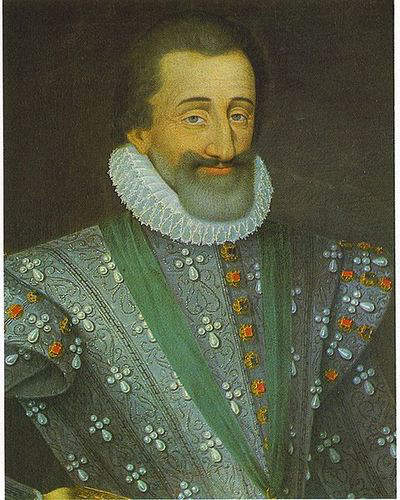
gHenry IV, the first Bourbon monarch of France (1589-1610)
The King is wearing a pearl-studded, green-colored robe, the pearls arranged in groups of five, forming a cross, with a drop-shaped pearl along the vertical line of the cross. K
Portrait by – Unknown Artist
Margaret of Valois – Wife of King Henry IV and Queen Consort of France and Navarre from 1589 to 1599
dThuruleee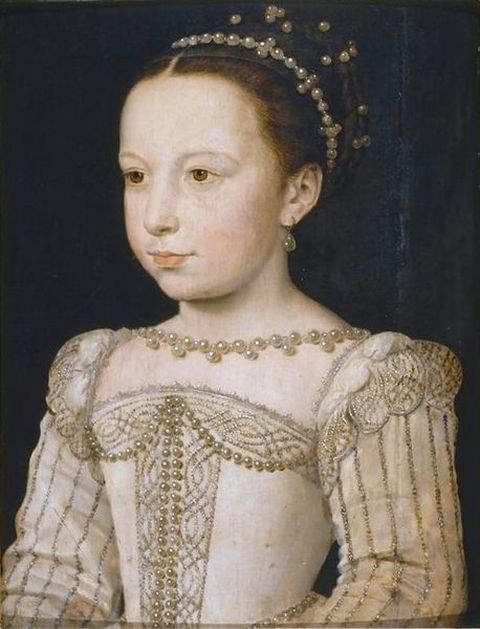
Margaret of Valois as a Young Princess
Ornaments Worn –
Single strand of pearls as head band.
Pearl ear-drops.
A strand of pearls across the shoulders.
Two pearl loops across the chest and a double-strand of pearls hanging from the depression of the loops.
Single strand of pearls around the hip.
Portrait by – Francois Clouet (1515-1572)
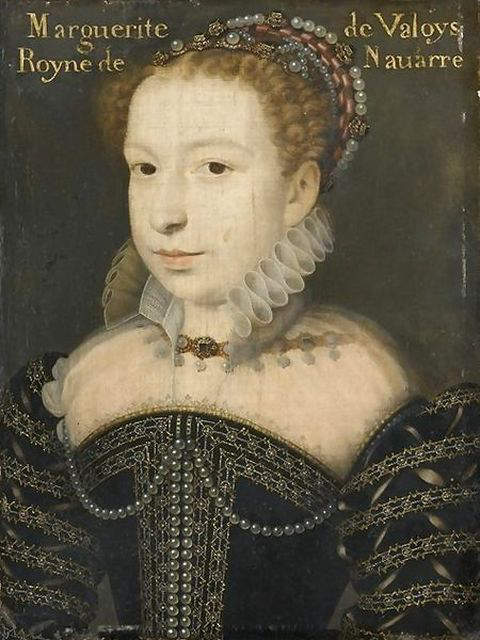
Margaret of Valois at age 19 years
Ornaments worn –
A single strand of large spherical pearls interspersed with colored stones as headband.
A second strand of small spherical pearls, interspersed with large spherical and colored stones, also as headband.
Two pearl loops across the chest and a double strand of pearls hanging from the depression of the loops.
A necklace set with pearls and colored stones.
Portrait by – Francois Clouet (1515-1572).
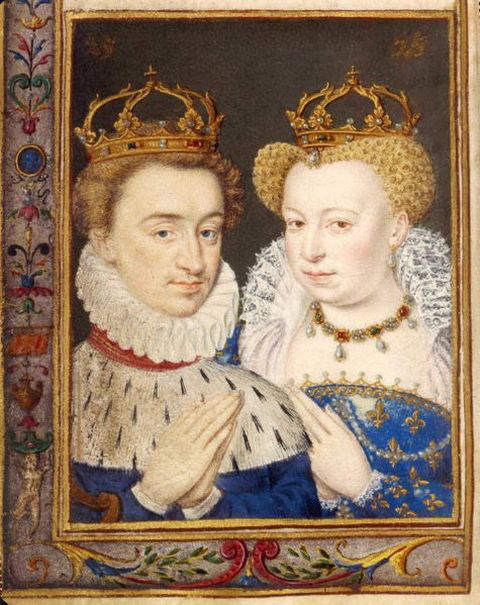
The Young King Henry of Navarre and his wife Margaret of Valois
Ornaments worn by Margaret of Valois –
A necklace set with pearls and colored stones with drop-shaped pearls hanging as fringes.
Double pearl loops across the chest, with a double strand of pearls hanging from the center.
Pearl ear-drops.
Drop-shaped pearl hanging from center of forhead.
Crown set with spherical pearls and colored stones.
The crown worn by King Henry of Navarre is also set with spherical pearls and colored stones.
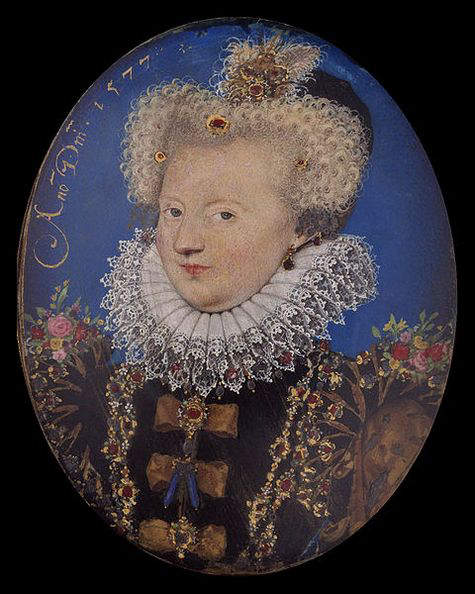
Margaret of Valois from a miniature by Nicholas Hilliard
Ornaments worn – In this miniature by Nicholas Hilliard apparently the ornaments worn by Margaret of Valois are predominantly set with colored stones, interspersed with small pearls. These ornament include the following:- A head ornament, drop earrings, necklaces and brooches.The colored stones used appear to be spinels or rubies, set on yellow gold. A few pearls are found mainly in the head ornament, the brooches and necklaces. Drop-shaped pearls appear to be incorporated on the elaborate collar of the dress mainly in the front.
The date of the work by Nicholas Hilliard is indicated in gold as “Ano Dni.1577” – Year 1577.
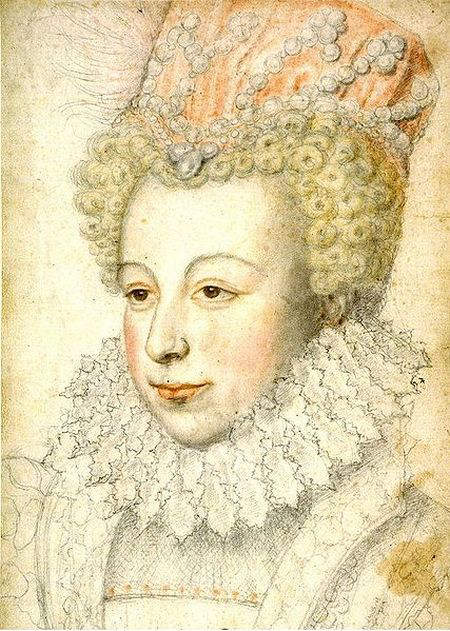
Portrait of Margaret of Valois by unknown author
Ornaments worn – The main ornaments worn by the queen as depicted in the portrait are head ornaments consisting of strings of pearls. A large drop-shaped with two smaller spherical pearls on either side is depicted on the Queen’s forehead.

Queen Margaret of Valois in 1605 after separation from her husband
Ornaments worn –
Pearl earrings with large drop-shaped pearl and several smaller spherical pearls.
Pearl necklace with a large drop-shaped pearl as centerpiece.
A zigzag row of pearls along the upper edge of the bodice of her dress.
A headdress with several pearls incorporated in it.
Portrait by– Unknown author
Marie de Medici – Wife of King Henry IV and Queen Consort of France and Navarre from 1600 to 1610 and Regent for King Louis XIII of France from 1610 to 1614
After King Henry IVth’s childless marriage to Queen Margaret of Valois was annuled in 1599, he married Marie de Medici in 1600, a marriage that produced six children. Marie de Medici was the queen consort of France and Navarre from 1600 until the assassination of King Henry IV in 1610, just the day after her coronation. She acted as regent for her son King Louis XIII of France, until he came of age.

Portrait of Marie de Medici by Peter Paul Rubens executed around 1622 to 1625
Ornaments worn –
Eardrops with large drop-shaped pearls.
Choker necklace with large spherical pearls.
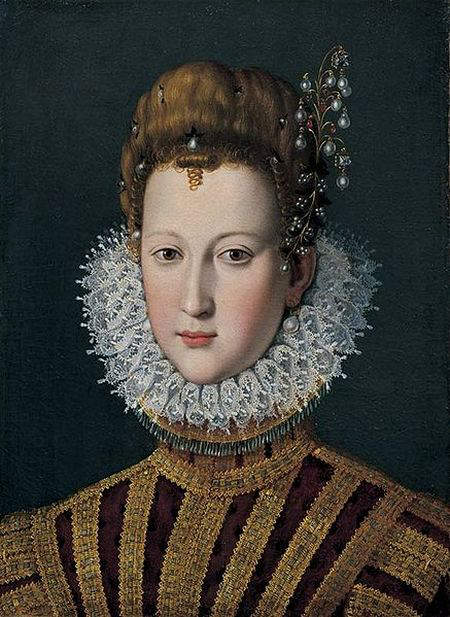
Contemporary portrait of young Marie de Medici
Ornaments worn –
Pearl hair ornament mounted on the side of the hairdo.
Pearl ear-drops.
Occasional dop-shaped pearls incorporated on the hairdo
Portrait by – the School of Santi di Tito
Anne of Austria – Wife of King Louis XIII and Queen Consort of France and Navarre from 1615 to 1643 and Regent for King Louis XIV of France from 1643 to 1651
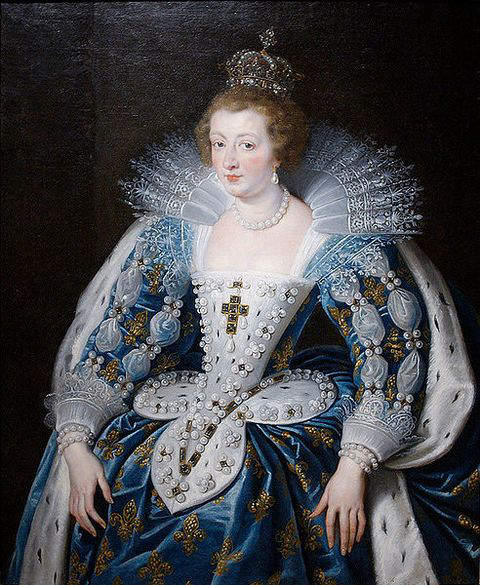
Portrait of Anne of Austria by Peter Paul Rubens executed around 1622 to 1625
Ornaments worn –
Pearl choker necklace made of large spherical pearls.
Drop earrings with large drop-shaped pearls.
Elaborate pearl-studded dress with pearls on the bodice, hip flaps and sleeves.
Cross-like stomacher set with colored stones and three large drop-shaped pearls hanging from below.
Double-strand pearl bracelets on both wrists.
Crown studded with pearls and colored stones.

Portrait of Anne of Austria in her later years from the châteaux de Versailles et de Trianon
Ornaments worn –
Drop earrings with large drop-shaped pearls.
Choker necklace with large spherical pearls.
Stomacher with six large drop-shaped pearls, four arranged vertically one below the other, and the other two horizontally in line with the second vertical pearl, forming a sort of cross.
Maria Theresa of Spain – wife of King Louis XIV and Queen Consort of France and Navarre from 1660 to 1683
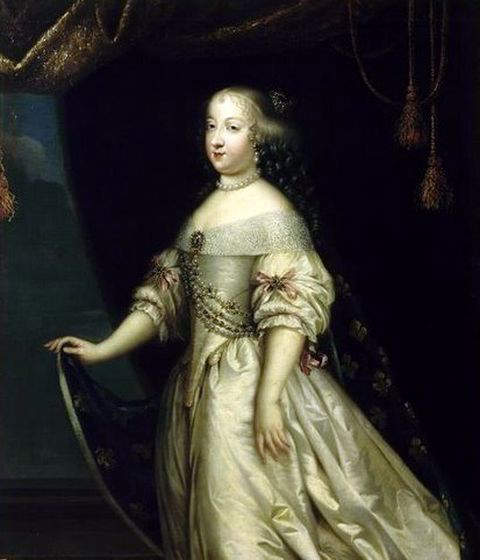
Portrait of Maria Theresa, Queen of France, by unknown artist
Ornaments worn –
Choker necklace with large spherical pearls.
Drop earrings with large drop-shaped pearls.
Stomacher set with colored stones and pearls.
Four strands stretching diagonally across the bodice of the dress, made of pearls and colored stones.
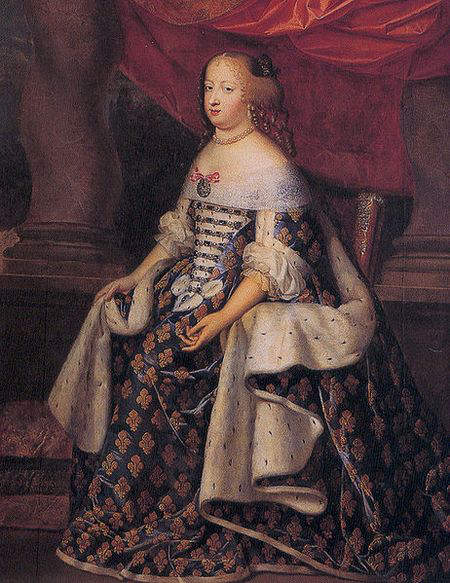
Portrait of Maria Theresa, Queen of France
Ornaments worn –
Choker necklace with large spherical pearls.
Drop earrings with large drop-shaped pearls.
Short strands of pearls hanging from the hair on the sides and behind.
Horizontal rows of pearls embroidered on the front flap of the dress.
Portrait by – Charles Beaubrun
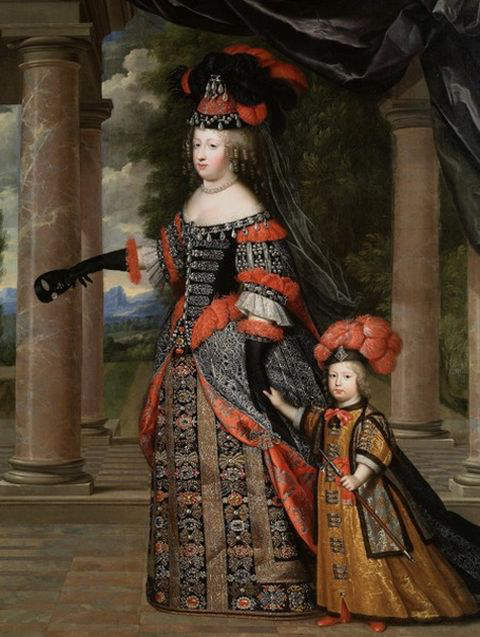
Maria Theresa and her son Dauphin Louis of France
Ornaments worn –
Cone-shaped headdress decorated with spherical and drop-shaped pearls.
Drop earrings with large drop-shaped pearls.
Choker necklace with large spherical pearls.
Spherical and drop-shaped pearls decorating the neckline of the dress, and drop-shaped pearls decorating the midline of the upper part of the dress.
Spherical pearls decorating the inner robe of the dress.
Portrait by – Pierre Mignard in 1661
Francoise d’Aubigne, Marquise de Maintenon – Second wife of King Louis XIV
Louis XIV’s marriage with Maria Theresa produced six children, although his relationship with her was not entirely faithful. Louis took a series of mistresses, prominent among whom were Mademoiselle de La Valliere, Madame de Montespan and Mademoiselle de Fontanges. After the death of Maria Theresa in 1683, Louis took as his second wife Francoise d’Aubigne, who was previously rewarded with large sums of money by the king, for providing services as nanny and governess, in bringing up his illegetimate child by his mistress Madame de Montespan, with which she purchased a property at Maintenon, and came to be known as Madame de Maintenon. Louis also gave her the title Marquise de Maintenon in 1678. Though the marriage of Louis with the Marquise de Maintenon was never officially announced or admitted, it was an open secret, and lasted until Louis’ death in 1715. According to historians Louis’ relationship with the Marquise de Maintenon proved to be more faithful than his relationship with the Queen Consort, Maria Theresa of Spain.

Francoise d’Aubigne, the Marquise de Maintenon, second wife of King Louis XIV
Ornaments worn –
Choker necklace consisting of large spherical pearls,
Drop-earrings with large drop-shaped pearls.
Single strand of spherical pearls around her rear hair knot.
A shoulder-pin set with spherical pearls.
Portrait by – unknown artist
Marie Leszczynska (Leczinska) – Wife of King Louis XV and Queen Consort of France and Navarre from 1725 to 1768

Portrait of Marie Leszczynska executed in 1730
Ornaments worn –
Stomacher with three drop-shaped pearls.
Pearl studded crown.
Pearls incorporated on the sleeves and neckline of the dress.
Portrait by – Jean Baptiste van Loo
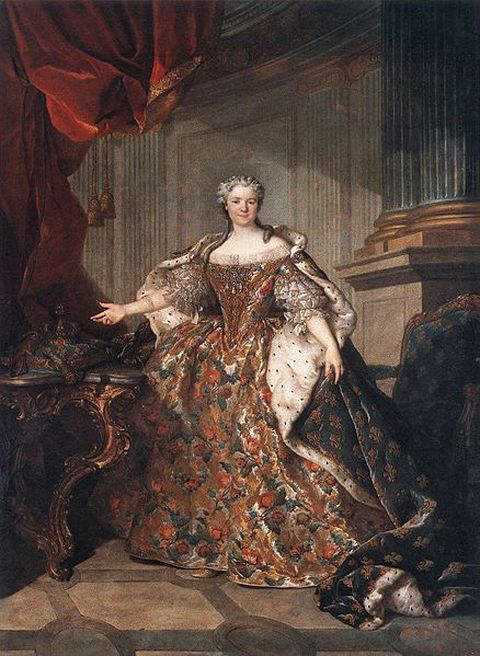
Portrait of Marie Leszczynska as Queen of France by Louis Tocque in 1740
Ornaments worn –
Stomacher with three drop-shaped pearls.
Pearl ear-drops.
Pearls incorporated on the sleeves of the dress.
Portrait by– Louis Tocque
Marie Antoinette – Wife of King Louis XVI and Queen Consort of France and Navarre from 1774 to 1792

Marie Antoinette at the age of seven years in 1762
Ornaments worn -Earrings with two sphericl pearls
Grey-colored bow with four spherical pearls on a white mounting hanging from its center.
Portrait by – Jean-Etienne Liotard
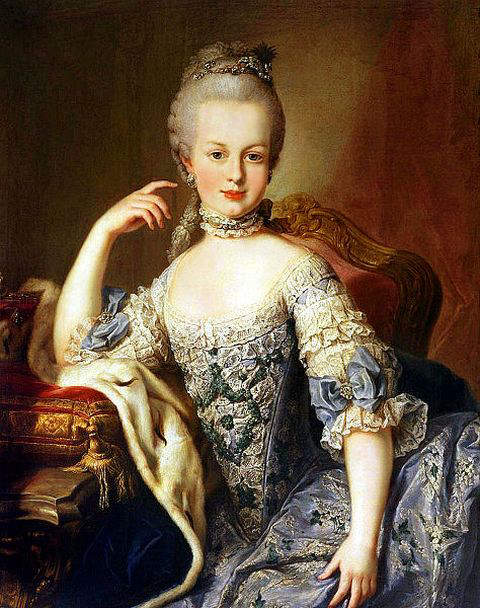
Marie Antoinette at the age of twelve
Ornaments worn –
Headband encrusted with pearls.
Earrings set with colored stones and small pearls.
Large bows on the sleeves, with centerpiece set with pearls and colored stones.
Portrait by – Martin van Meytens in 1767
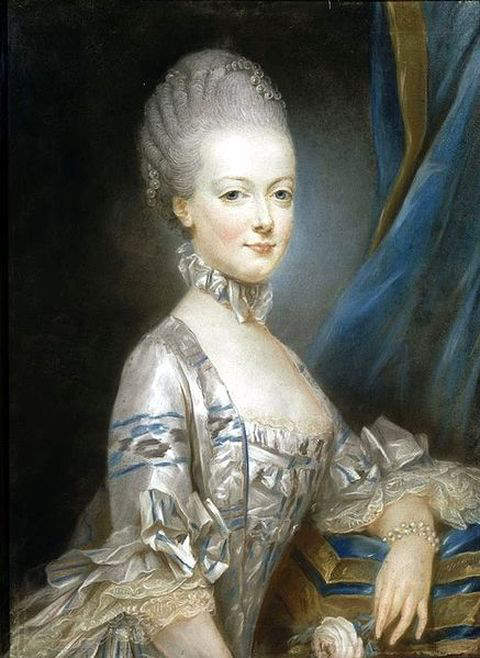
Marie Antoinette at the age of thirteen
Ornaments worn –
Single strand of pearls incorporated into the elaborate hairdo.
Double stranded pearl bracelet.
Portrait by – Joseph Ducreux in 1769. The miniature portrait was sent to the dauphin Louise-Auguste to enble him see his bride before the marriage.
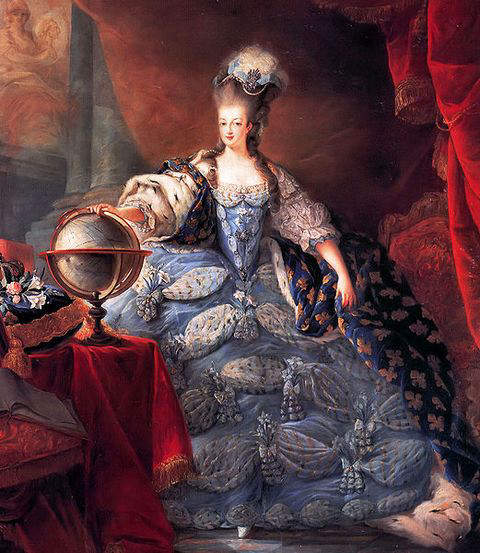
Marie Antoinette in Coronation Robes in 1775
Ornaments worn -Single strand of pearls and pearl ornament on the elaborate headdress.
Drop-shaped pearls hanging from the side of the hairdo.
Pearls embroidered on the elaborate coronation robe.
Portrait by – Jean-Baptiste Gautier Dagoty in 1775
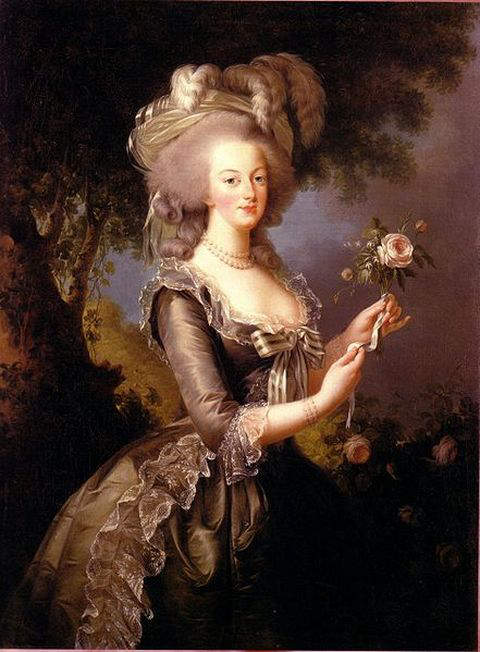
Marie Antoinette in 1783
Ornameents worn –
Double strand pearl necklace.
Triple strand pearl bracelets on both hands.
Portrait by – Eliszbeth Vigee Le Brun in 1783.
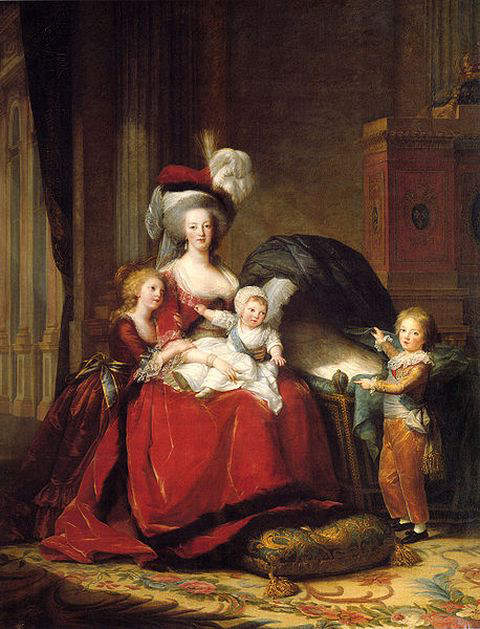
Portrait of Marie Antoinette and her three children, Marie Therese, Louis Charles, and Louis Joseph, also by Elisabeth Vigee Le Brun in 1787
This state portrait of Marie Antoinette with her children, also executed by Elizabeth Vigee Le Brun in 1787, dressed in simple attire devoid of any ornaments, except her pearl drop earrings, was in fact a public relations exercise designed to improve the image of the queen as a mother in spite of her royal status. It is doubtful whether such attempts to correct the public perception of the royal family, had the desired effect from the events that unfolded subsequently. It is also highly unlikely that such attempts would have had any effect at all given the strong anti-Austrian feeling among the French public at that time.

1788-Portrait of Marie Antoinette also by Elisabeth Brun
Ornaments worn –
Four-strand pearl necklace
Pearl drop-earrings
Portrait by – Elizabeth Vigee Lebrun

Portrait of Marie Antoinette by Alexandre Kucharski, probably around 1791, at the height of the French revolution
Ornaments worn –
Single strand necklace with large spherical pearls.
Double strand of pearls around her hair.
Alexander Kucharski’s portrait is said to be highly realistic, for despite her relatively young age, being only 36, anxiety and worry is clearly depicted on the Queen’s face caused by the tumultous events of the period.
Appreciation of pearls by the wives of Napoleon Bonaparte, Emperor of the French from 1804 to 1814
Josephine de Beauharnais – First wife of Napoleon Bonaparte and first Empress of the French from 1804 to 1810
Louis XVI was the 5th in the line of Burbon monarchs that began with Henry IV who ruled from 1589 to 1610. After the overthrow of the monarchy during the French revolution, the first republic was proclaimed in 1792, that lasted until 1804, when its first consul Napoleon Bonaparte, declared himself the Emperor of the French. Napoleon Bonaparte’s First Empire lasted from 1804 to 1814. Napoleon Bonaparte met his first wife, Josephine de Beauhanais – a widow and mother of two children, whose husband Alexandre de Beauharnais was guillotined to death during the French revolution in 1794 – in 1795, and they were married in 1796. Josephine was not faithful to her husband and during his absence from France at the time of the military campaigns of Italy and later Egypt, had affairs with other men, such as the handsome Hussar Lieutenant, Hippolyte Charles. Napoleon too started affairs with other women during his military campaigns. However, in spite of these shortcomings their marriage survived, and at one point just before the coronation in December 1804, when matters reached a breaking point, it was the intervention of Hortense de Beauharnais, the daughter of Josephine, who was able to reconcile both parents, that saved the marriage.
Napoleon crowned himself as the Emperor of France, on December 2, 1804, at a ceremony officiated by Pope Pius VII, and later crowned Josephine as his Empress. Their marriage lasted until January 1810, when Josephine agreed to a divorce being unable to bear him a child who would become his heir. Josephine lived at Chateau de Malmaison after the divorce, and continued to have good relations with the Emperor. She died in May 1814, just one month after Napoleon was forced to abdicate in April 1814. Napoleon’s relationship with Josephine had puzzled many historians. In spite of their tumultous relationship that was initially tainted by extra-marital affairs on both sides, and subsequent divorce and remarriage, Napoleon appeared to be deeply in love with Josephine, as revealed by the Emperor’s last words on his death bed at St. Helena, “France, the Army, the Head of the Army, Josephine.”
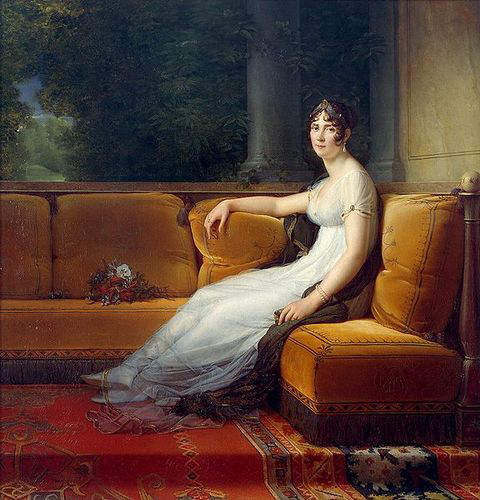
Portrait of Empress Josephine executed in 1801 by Francois Gerard
Ornaments worn –
Drop-earrings with large drop-shaped pearls.
Double strand pearl bracelet.
Inverted v-shaped tiara with a single drop-shaped pearl at either end.

Official Portrait of Empress Josephine in 1808, executed by Francois Gerard
Ornaments worn-
Fringe necklace of colored stones and drop-shaped pearls.
Drop earrings with large drop-shaped pearls.
Single strand pearl bracelet on each wrist.
Crown incorporating spherical and drop-shaped pearls.
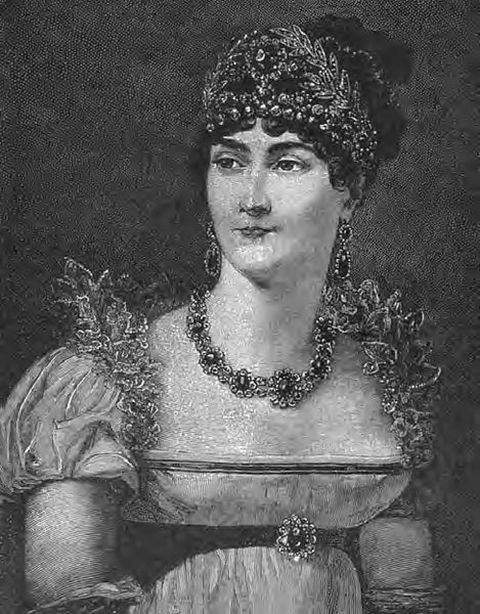
Portrait of Josephine from Ridpath’s History of the World published in 1901
Ornaments worn –
Necklace of colored stones and pearls.
Drop-earrings of colored stones and pearls.
Brooch with colored stone surrounded by pearls.
Tiara of colored stones and pearls.
Marie Louise – Second Wife of Napoleon Bonaparte and Empress Consort of the French from 1810 to 1814
After divorcing Empress Josephine in January 1810, Napoleon Bonaparte married Archduchess Marie-Louise of Austria, in April 1810, the 18-year old daughter of Francis II, Holy Roman Emperor and his second wife Maria Teresa of Naples and Sicily and a grandniece of the unfortunate Marie Antoinette, beheaded during the French revolution. Napoleon Bonaparte’s intention in contracting this marriage was not only to fulfill his dream of having a male heir to continue the Bonaparte dynasty founded by him, but also to validate and legitimize his empire by marrying into one of the oldest ruling families of Europe, the House of Hapsburg. Marie-Louise was able to fulfil Napoleon’s dream by giving birth to a son on March 20, 1811, who was named Napoleon Francois Joseph Charles Bonaparte, given the title of King of Rome and later Duke of Reichstadt.
During Napoleon’s Russian campaign from April to December 1812, and the German campaign from April 1813 to January 1814, Marie-Louise acted as the regent of France. However, after Napoleon’s defeat and forced abdication in April 1814, and subsequent exile to the island of Elba, Marie-Louise returned to Austria with her son, and would never see her husband again. After her return to Austria, she was, made the Duchess of Parma, which she ruled until her death in 1847. In 1821, four months after Napoleon died in exile, Marie-Louise married her lover, Count Adam Albert von Neipperg, by whom he had three children. Count Adam Albert died in 1829, and five years later in 1834 she married again Charles-Rene, Count of Bombelles.
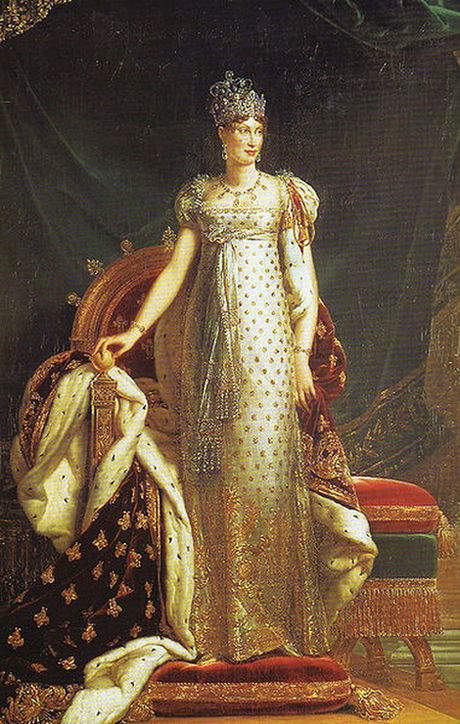
1811-Portrait of Marie Louise, Empress Consort of the French
At the time of Napoleon’s wedding to Marie-Louise on April 2, 1810, the emperor is reported to have presented to his new bride an expensive emerald and diamond parure, that was designed by the court jeweler Francois Regnault Nitot. Later he lavished more expensive parures on his Empress Consort, particularly after the birth of his much desired son and heir-apparent, on March 20, 1811. It was reported that by the end of the year 1913, Napoleon had purchased jewelry to the value of 6.6 million gold francs from Francois Regnault Nitot. Among the jewelry gifted to Marie-Louise was a magnificent pearl parure, consisting of a pearl tiara incorporating the 346.27-grain, drop-shaped, silvery-white “Perle Napoleon,” a pair of bracelets, matching earrings, a three-row pearl necklace and a pearl sautoir made of 408 spherical pearls.
Ornaments worn in the above portrait–
A fringe necklace with colored stones and drop-shaped pearl fringes.
Drop-earrings incorporating colored stones and pearls.
Crown incorporating pearls and colored stones.
Bracelets with pearls and colored stones.
Pearls incorporated in the dress and throne-like seat.
Portrait by – Francois Gerard
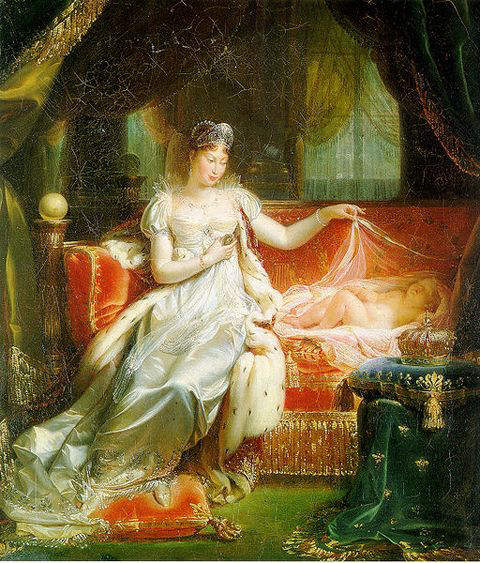
Marie-Louise with her son Napoleon II – unknown arist 1811
Ornaments worn –
Pearl and colored stone fringe necklace.
Pearl and colored stone bracelets.
Pearl drop-earrings.
Tiara set with colored stones and pearls.
Crown set with colored stones and pearls.
Pearl embroidered cushion cover and green silk-like cloth, covering the table-like mount on which the crown is placed.
Portrait by – Joseph Franque in 1811
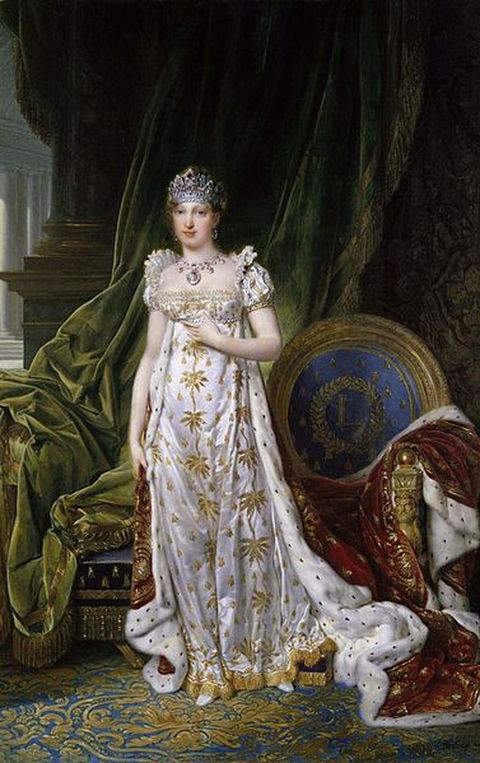
1810-portrait of Marie Louise, Empress Consort of France
Ornaments worn –
Fringe necklace of colored stones and pearls.
Crown set with colored stones and pearls.
Drop earrings with colored stones and pearls.
Portrait by – John Baptiste Isabey in 1810.
Appreciation of pearls by the ladies of the restored Bourbon monarchy
Marie Therese, the Duchess de Angouleme – Daughter of Marie Antoinette, Wife of Dauphin Louis Antoine, eldest son of King Charles X of France and Navarre (1824-1830)
After the defeat of Napoleon Bonparte in 1814, the allied armies restored the Bourbon monarchy as a constitutional monarchy, and Louis Stanilas Xavier, younger brother of King Louis XVI and uncle of Louis XVII, the titular king who died in prison in 1795, ascended the throne as King Louis XVIII. Save for a short period of around 100 days in 1815, when Napoleon staged a come back after his escape from the island of Elba, Louis XVIII ruled as the King of France and Navarre from 1814 to 1824. Louis XVIII’s wife Marie Josephine of Savoy died on Novmber 13, 1810, while they were still living in exile in Hartwell House, Buckinghmshire, England. The marriage did not produce any children; hence after Louis XVIII’s death in 1824, the crown passed to his younger brother Charles, the Comte d’Artois, who ascended the throne as Charles X.
Charles married Marie Therese of Savoy, by whom he had two children, Louis Antoine, Duke of Angouleme and Charles Ferdinand, Duke of Berry. Marie Therese of Savoy died in exile in Austria in 1805. Louis Antoine married his cousin sister Marie Therese in 1799, the daughter of Louis XVI and Marie Antoinette, a marriage that was encouraged by their uncle, the future King Louis XVIII. However, the marriage did not produce the expected offsprings that would ensure the future of the Bourbon monarchy. In February, 1820, Charles X’s younger son, the Duke of Berry was assassinated at the Paris Opera, that placed the continuation of the Bourbon dynasty in jeopardy, as high hopes were placed on him to produce the much-needed male heir. Soon after his death it was found that his widow Caroline of Naples and Sicily was pregnant, and she gave birth to a son on September 29, 1820. His birth was considered a miracle, and the people of France bought him the Chateau de Chambord in celebration of his birth. The son was named Henry, who was made the Duke of Bordeaux, and an elated King Louis XVIII added the title Count de Chambord.
Charles X ruled fom 1824 until the July revolution of 1830. His eldest son Louis Antoine, the Duke d’Angouleme was the Dauphin or the heir to the throne. In the absence of a queen, Charles X’s daughter-in-law Marie Therese, the Duchess d’Angouleme played the role of the queen, a role she played for ten years during the reign of her widower uncle King Louis XVIII from 1814 to 1824.
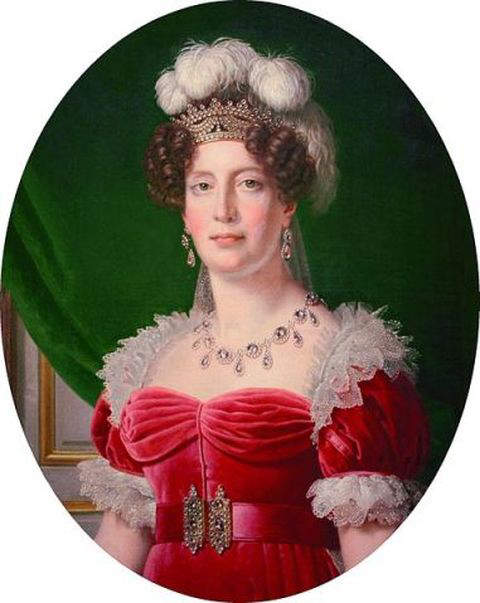
Marie Therese – The Duchess de Angouleme
Ornaments worn –
Fringe necklace with colored stones and pearls.
Drop-earrings with colored stones and pearls.
Tiara encrusted with pearls only.
Belt buckle encrusted with pearls and colored stones.
Maria Amalia of Naples and Sicily – Queen of the French and wife to Louis Philippe I, King of the French, from 1830 to 1848
Following the July revolution of 1830 the six-year rule of Charles X came to an end. By-passing his son Dauphin Louis Antoine, the heir to the throne, Charles abdicated on August 2, 1830, in favour of his grandson Henry, Duke of Bordeaux, who was a minor and appointed Louis Philippe as the regent. However, the Chamber of Deputies decided that Louis Philippe d’Orleans of the cadet branch of the House of Bourbon should take the throne from King Charles, and accordingly on 9th August 1830, Louis Philippe ascended the French throne as Louis Philippe I, taking the title of “King of the French.” Louis Philippe’s wife Maria Amalia of Naples and Sicily took the title of “Queen of the French.” Louis Philippe was the last king to rule France, and his reign lasted from 1830 to 1848, when he himself was forced to abdicate by the declaration of the second republic following the 1848 revolution.
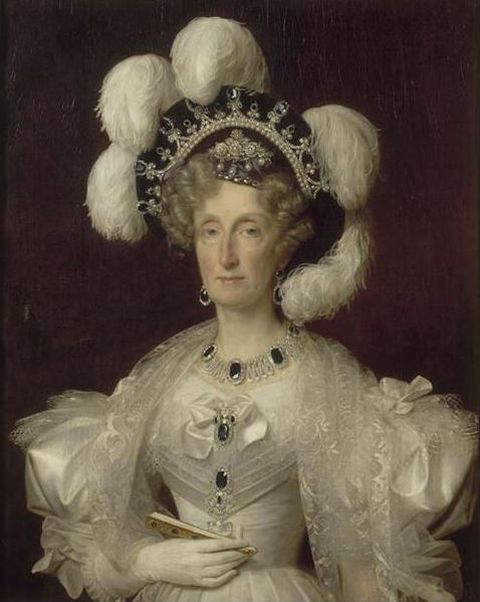
Maria Amalia of the Two Sicilies
Ornaments worn-
Necklace set with colored stones and pearls.
Drop-earrings with colored stones and pearls.
Stomacher with colored stones and pearls.
Elaborate tiara set with colored stones and pearls.
Portrait by – Louis Hersent
Appreciation of pearls by the Empress Consort of Napoleon III of the restored second empire
Eugenie de Montijo – Empress Consort of the French and wife of Napoleon III, last Emperor of the French from 1853 to 1871
After the declaration of the second republic in 1848, Napoleon Bonaparte’s nephew Louis Bonaparte returned from exile in Britain, and in the election that was held the same year, was elected president of the second republic by a landslide victory polling 5.5 million votes. Louis Napoleon ruled France as the President of the second republic for a four-year term until 1852. Towards the end of his first term he drafted a new constitution and capitalizing on his popularity got it approved by a plebiscite, and subsequently held another plebiscite that ended the second republic and ushered in the Second Empire on December 2, 1852, transforming him from elected president to an absolute emperor, taking the title “Napoleon III, Emperor of the French.” Soon after becoming emperor Napoleon III married the Countess of Teba, Eugenie de Montijo, on January 30, 1853, a Spanish noble woman who had been brought up in Paris. It was in anticipation of this marriage that the court jewelers Gabriel Lemonnier and Francois Kramer designed an entirely new pearl parure using crown jewels previously used by Marie Louise and Marie Therese, on the orders of Napoleon III. This pearl parure consisted of a pearl and diamond tiara, a six-stranded pearl necklace, pearl bracelets, and a diamond stomacher incorporating the “Perle Napoleon.” Winterhalter, artist of the 19th-century painted Empress Eugenie wearing this pearl parure in 1853 soon after her wedding to Napoleon III.
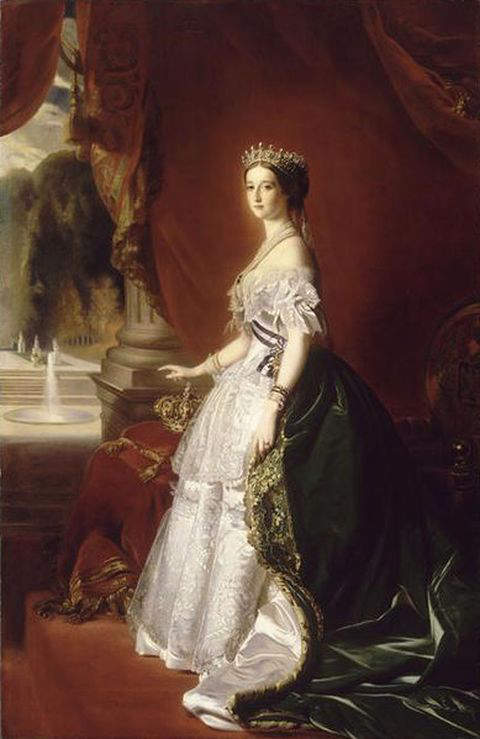
Portrait of Empress Eugenie in 1853, wearing the famous pearl parure
Portrait by – Franz Xaver Winterhalter
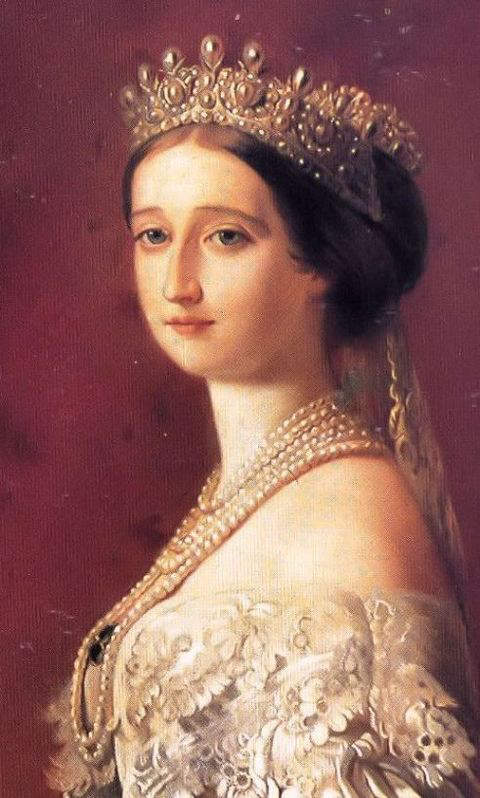
Close-up of the above portrait by Winterhalter
Ornaments Worn –
Empress Eugenie Pearl and Diamond Tiara.
A six-strand pearl necklace.
Pearl bracelet on each hand.
Diamond and pearl stomacher.
Empress Eugenie transformed most of the old pieces in the Crown Jewels of France into new settings, to suit her own taste and the fashion trends of the period, using the services of the court jewelers Gabriel Lemonnier. She also added several new pieces to the crown jewels of France, such as a Greek diadem incorporating the famous Regent Diamond, once mounted on the hilt of Napoleon’s sword.
The Use and Appreciation of Pearls by the monarchies of Great Britain from 1714 until the reign of Queen Elizabeth II in modern times
Queen Anne was the last monarch of the House of Stuart and the first Queen of Great Britain that was created on May 1, 1707 with the merger of the Kingdom of England and the Kingdom of Scotland. She ruled as the Queen of England, Scotland and Ireland from 1702 to 1707, and under the Acts of Union of 1707, when England and Scotland united to form Great Britain, she became the Queen of Great Britain and Ireland from 1707, until her death in 1714. Thus, technically she was the last Queen of England and also the last Queen of the Scots. In 1683 Anne married Prince George of Denmark, a Protestant. The marriage turned out to be one of great domestic happiness, but unfortunately Anne and George could not raise a family with healthy children, which they very much desired. By the year 1700, Anne had been pregnant at least 18 times, out of which 13 times she miscarried or gave birth to still born children. She gave birth to five children of which four died before reaching the age of 2 years. Anne’s only surviving child, William, the Duke of Gloucester, died at the age of 11 years, on July 29, 1700, devastating both parents and precipitating a succesion crisis.
After the Glorious Revolution of 1688, William of Orange (William III) and Mary II became the co-rulers of the kingdoms of England, Scotland and Ireland. However, William and Mary had no children that prompted parliament to enact the Bill of Rights of 1689, that settled the issue of succession to the throne. According to this bill princess Anne and her descendants were to be in the line of succession after William and Mary. They were to be followed by any descendants of William by any future marriage. When in 1700, Princess Anne’s only surviving child died, it appeared that Princess Anne was the only individual remaining in the line of succession established by the Bill of Rights of 1689, leaving open the possibility that the deposed Catholic king James or his son could claim back the throne. To prevent a Catholic restoration, Parliament enacted the Act of Settlement of 1701, which provided that failing the issue of Princess Anne and of William III by any future marriage, the Crown would go to the Protestant Sophia, Electress of Hanover and her descendants. Sophia was the granddaughter of King James I through his daughter Elizabeth, who was the sister of Anne’s grandfather Charles I.
Mary II died of smallpox in 1694, and William III ruled alone until his death in 1702. Princess Anne who was the next in line of succession to the throne according to the Bill of Rights, ascended the throne on April 23, 1702. Queen Anne ruled until May 1, 1707 as Queen of England, Scotland and Ireland and after the Acts of Union took effect as Queen of Great Britain and Ireland until her death on August 1, 1714. Soon after Queen Anne’s death, the Act of Settlement of 1701 took effect, and by-passing over fifty Catholics who were closer blood relations of Queen Anne, the 54-year old George, the eldest son of Sophia, the Electress of Hanover and her husband Ernest Augustus, the Duke of Brunswick, ascended the British throne as King George I of Great Britain and Ireland, the first British Monarch of the House of Hanover.
Appreciation of pearls by the spouses of the monarchs of the House of Hanover
Sophia Dorothea of Celle – Wife of King George I, before he ascended the throne
At the time King George I ascended the throne he was a divorcee, having already married Sophia Dorothea of Celle in 1682 and divorced her in 1694, after 12 years of marriage. The marriage produced two issues, a son, George Augustus, who subsequently succeeded his father as King George II, and a daughter Sophia, who became the Queen of Prussia.
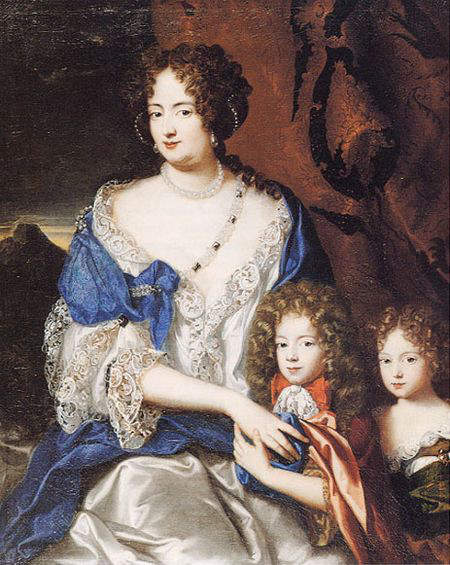
Sophie Dorothea of Celle, wife of King George I, before he ascended the throne in 1714. Her two children George Augustus and Sophia are also with the mother.
Ornaments worn –
A single-strand pearl necklace.
Drop-earrings with large drop-shaped pearls.
A pearl strand incorporated into her hairdo.
A three-strand pearl sautoir interspersed with colored stones placed across the chest and one shoulder, and going round her body.
Portrait by – Jacques Vaillant
Sophia Dorothea of Celle in 1686
Ornments worn –
The only ornaments worn by Sophia Dorothea in this portrait by Henry Gascard in 1686 are a pair of pearl drop earrings with large, white, perfectly drop-shaped pearls.
Caroline of Brandenburg-Ansbach – Queen Consort of King George II of Great Britain and Ireland from 1727 to 1737
George Augustus, son of King George I married Caroline of Brandenburg-Ansbach in 1705, nine years before George I ascended the British throne as the first monarch of the House of Hanover. Between 1705 and 1714, the year King George I ascended the throne, George Augustus’ marriage to Caroline had produced four children, an eldest son, Prince Frederick followed by three daughters, all born in Hanover. After King George I ascended the throne, George Augustus, Caroline and the three daughters moved to England leaving Prince Frederick in Hanover to be educated by private tutors. When George I ascended the throne, his son George Augustus became the Prince of Wales and the heir to the throne, and Caroline became the Princess of Wales. Since King George I had already divorced his wife long before he ascended the throne, Caroline, the Princess of Wales became the highest ranking woman in the royal household and the kingdom. After arriving in England Caroline gave birth to four more children, two sons and two daughters. In 1727, when King George I died, the Prince of Wales, George Augustus ascended the throne as King George II, and Caroline became his queen consort. Caroline was queen consort from 1727 until her death in 1737. During this period she worked tirelessly as an intermediary between the king and parliament, by establishing a close working relationship with Sir Robert Walpole, the prime minister. She supported clemency for the Jacobites, freedom of the press and freedom of speech in Parliament. She also acted as regent to the king on several occasions when the king left the country to Hanover. As Princess of Wales and later as Queen, Caroline surrounded herself with intellectuals, writers and artists. She was a connoisseur of the visual arts, and collected portraits and miniatures and jewelry, especially cameos and intaglios. When Queen Caroline died in 1737, she was mourned widely, even by the Jacobites who acknowleged her compassion and mercy shown to their compatriots. Queen Caroline has gone down as one of the most influential queen consorts in British history. She is credited for laying the foundation for the establishment of the Hanoverian dynasty in Britain, in the face of Jacobite opposition.

Caroline of Brandenburg Ansbach – Queen Consort of King George II
Ornaments worn -Pearl embroidered dress.
Hair ornament with pearls.
Two loops of pearls fixed to each shoulder of the upper part of the dress.
Several loops of pearls hanging like festoons midway around the sleeves.
A long pearl rope going round the hip and hanging in front as a double strand extending down almost to the edge of the long dress.
The Queen is also holding a crown studded with rows of pearls.
Portrait by – Charles Jervas
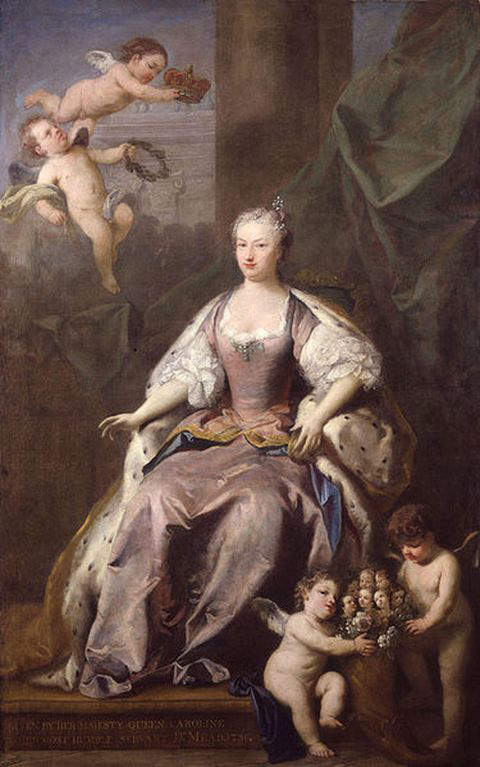
Portrait of Queen Caroline executed in 1735 by Jacopo Amigoni
Ornaments worn –
Pearl hair ornament.
Pearl stomacher.
Charlotte of Mecklenburg – Wife of King George III and Queen Consort of the United Kingdom from 1761 to 1818.
King George II ruled for 33 years from 1727 to 1760. He outlived his wife and queen consort, Caroline of Brandenburg-Ansbach, who died in 1737 by 23 years. On his death in October 1760, two weeks before his 77th-birthday, his grandson the Prince of Wales, Prince George William Frederick, the son of Prince Frederick and Princess Augusta of Saxe-Gotha, ascended the throne as King George III of Great Britain and Ireland, who subsequently became the King of the United Kingdom of Great Britain and Ireland after the union of the two countries on January 1, 1801. King George III was the third British Monarch of the House of Hanover and the first monarch of the House of Hanover, born in Britain and spoke English as his first language. He lived for 82 years, and during his long life never visited Hanover, the home of his ancestors. His long rule of 60 years was marked by several military conflicts involving Britain that significantly altered the course of world history, such as the Seven Years War in which Britain defeated France, becoming the dominant European power in North America and India; American War of Independence that led to the establishment of the United States of America in 1776; a series of wars against revolutionary and Napoleonic France, that finally ended with the defeat of Napoleon in 1815; and military conflicts in Asia, particularly India and Africa that asserted Britain’s position as the leading colonizing power in the world.
King George III married Princess Charlotte of Mecklenburg-Strelitz on September 8, 1761. The marriage turned out to be one of the happiest in the history of the British monarchies, George III setting high moral standards, never taking a mistress like his predecessors, and the genuinely happy relationship producing 15 children, nine sons and six daughters, all of whom survived into adulthood except for two sons, Prince Octavius and Prince Alfred. Queen Charlotte was a great connoisseur and patron of the arts and music, and an amateur Botanist who took a keen interest in enriching and expanding the collection in the Kew Gardens using new species and varieties of plants brought in by travellers and explorers such as Captain Cook and Sir Joseph Banks. Queen Charlotte was a dutiful wife and took good care of her husband in later years during his bouts of insanity, being her husbands legal guardian from 1811 until her death in 1818. She predeceased her husband by two years.
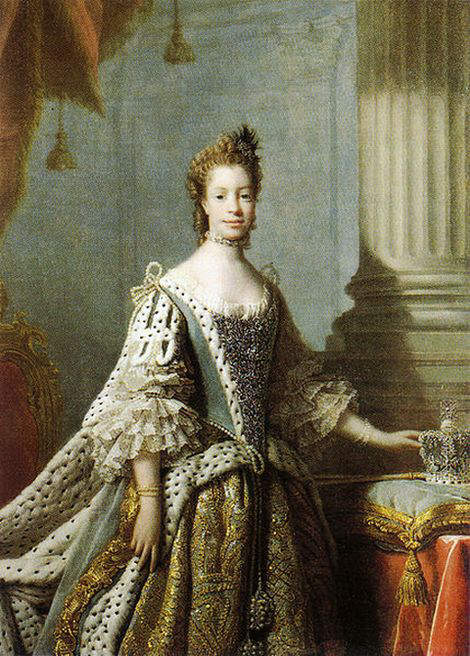
Portrait of Queen Charlotte, consort of King George III, by studio of Allan Ramsay in 1762
Ornaments worn –
Pearl dog collar necklace.
Pearl hair ornament.
Pearl bracelets.
Pearl loops on the shoulders of her dress.
Pearl rope around her hips and hanging vertically in front of her dress.
A crown studded with pearls.
Pearl embroidered dress.
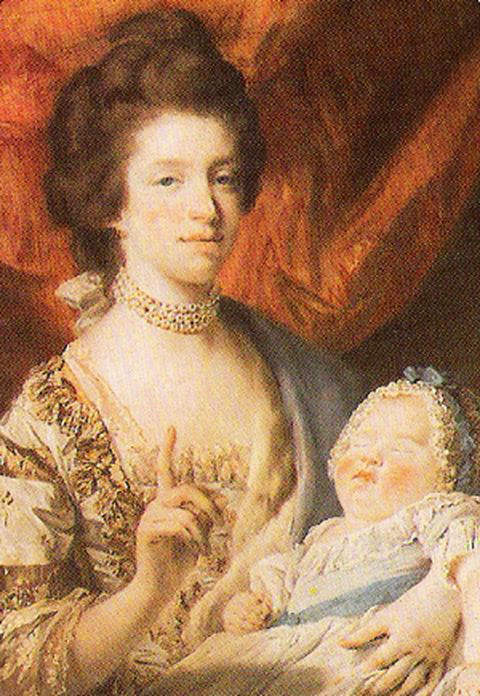
Queen Charlotte in 1767 wth her eldest daughter Charlotte, Princess Royal
Ornaments worn –
The only ornament worn by the queen in this pastel portrait drawn in 1767 appears to be a 3-strand dog-collar pearl necklace.
Portrait by – Francis Cotes in 1767
Caroline of Brunswick – Wife and Queen Consort of King George IV of the United Kingdom from January 29, 1820 to August 7, 1821
After King George III died on January 29, 1820, he was succeeded by his eldest son, the Prince of Wales George Augustus Frederick, who ascended the throne as King George IV. The new king however, had already gathered some experience in governing, as he served as Prince Regent from 1811, during his father’s final bout of mental illness. During his regency he was a trend setter in new fashions, style, taste and manners and earned the title of “First Gentleman of England.” His achievements include building of the Royal Pavilion in Brighton, remodelling of the Buckingham Palace, rebuilding Windsor Castle, founding of the National Gallery, London and King’s College, London. His strained relationship with his father and wife, Caroline of Brunswick, and his extravagant and dissolute life style, involving heavy drinking, numerous mistresses, and escapades, in stark contrast to his father’s scandal-free life style, setting high moral standards, earned him the contempt of the people, and lowered the prestige of the monarchy.
In 1795 under pressure from his father, he agreed to marry his cousin sister, Caroline of Brunswick. This marriage, unlike that of King George III’s, that has gone down in British History as one of the most successful royal marriages, was a disaster right from the beginning, as the partners were not compatible, and led to their formal separation, soon after the birth of their only child, Princess Charrlotte, in 1796, and remained separated for the rest of their lives, though not divorced. However, both of them had their own affairs despite their royal status. In 1814, Caroline left the United Kingdom for Continental Europe, but decided to return for her husband’s coronation in 1821, to assert her rights as Queen Consort. However, George IV refused to recognize Caroline as Queen, and sought a divorce, but withdrew it on advice given by his legal experts fearing a scandal that would necessarily follow the exposure of the King’s extra-marital relationships in court. Instead on legal advice he introduced the “Pains and Penalties Bill” of 1820, that could have empowered Parliament to impose legal penalties without a trial in a court of law. The aim of the bill was to annul his marriage to Caroline, and strip her of the title of Queen. The bill proved so unpopular with the public that it was withdrawn from Parliament. Despite all this legal setbacks, the King decided to exclude his Queen Consort from his coronation at Westminster Abbey, on July 19, 1821. Caroline fell ill that day and died on 7th August 1821.

Caroline of Brunswick, Queem Consort of King George IV of the United Kingdom
Ornament worn –
Two-strand pearl dog-collar necklace.
A peal rope loosely wound around her right hand.
Wedding ring on the second finger of her left hand.
Portrait by – James Lonsdale in 1820. In the portrait the Queen’s hands are arranged to display her wedding ring in order to emphasize her fidelity to her marriage vows.
Princess Adelaide of Saxe-Meiningen – Wife of King William IV and Queen Consort of the United Kingdom from 1830 to 1837
George IV’s brief marriage to Caroline of Brunswick produced his only legitimate child, Princess Charlotte Augusta of Wales, who would become the Princess of Wales and heir to the British throne, whenever he ascended the throne. In 1816, Princess Charlotte married Prince Leopold of Saxe-Coburg-Saalfield, but in November 1817, she died of post-partum complications, after delivering a still born son. After the death of Princess Charlotte, Prince Frederick, the Duke of York, the second son of George III, and Prince William, the Duke of Clarence, the third son of George III, became respectively the 2nd and 3rd in line of succession to the British throne. The chances of George IV or his brother Prince Frederick, both of whom were without legitimate heirs and estranged from their wives, producing an heir to the throne was very remote. This prompted Prince William, the third in line of succession to the throne, who had hitherto married unofficially an Irish actress Dorothea Bland and fathered ten illegetimate children, to consider seriously of a legal marrige, that would perhaps produce an heir to the British throne. However, if he would outlive both his elder brothers, Prince George and Prince Frederick, he was certain to inherit the crown and any legitimate child from his proposed marriage would then inherit the crown from him. After an extensive search in Europe, eventually a princess was found who was not only friendly and home-loving, but also willing to accept William’s nine surviving illegitimate children, most of whom had not reached adulthood. The proposed bride was the 25-year old, Princess Adelaide of Saxe-Meiningen, who married the 53-year old Prince William on July 11, 1818. The marriage turned out to be a happy and successful one and lasted twenty years until the death of William. William was faithful to his wife and did not take any mistresses after the marriage. William’s behaviour also changed remarkably after the marriage, reducing the consumption of alcohol and other evils associated with it. However, the marriage did not produce the much-anticipated heir to the throne. The couple had two short-lived daughters, and twin boys who were still born, and Princess Adelaide suffered three miscarriages.
On January 29, 1820, when King George III died, he was succeeded by his eldest son, the Prince of Wales, George Augustus Frederick, who ascended the throne as King George IV. The kings brother, Prince Frederick, the Duke of York, now became the heir to the British throne, as the king had no surviving legitimate heir. In 1827, Prince Frederick, the Duke of York and heir to the British throne, also died childless, paving the way for Prince William, the Duke of Clarence, to become the heir-presumptive to the British throne. Eventually, when King George IV died on June 26, 1830, the 64-year old Duke of Clarence, Prince William ascended the throne as King William IV, the oldest person ever to assume the British throne. Princess Adelaide of Saxe-Meiningen thus became the Queen Consort of the United Kingdom. Queen Adelaide became popular among the British people, for her kindness, piety, modesty and charity. She also treated young Princess Victoria of Kent, heir-presumptive to King William, with kindness, despite her own inability to produce an heir. King William IV died in 1837, and Queen Adelaide survived her husband by 12 years, and died in 1849 during the reign of her niece Queen Victoria.
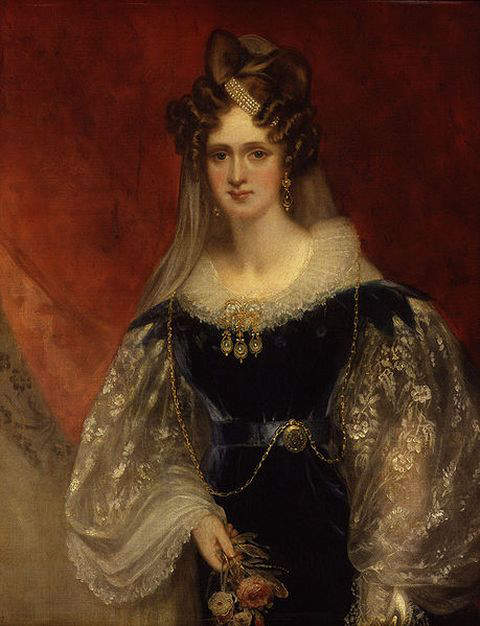
Princess Adelaide of Saxe-Meiningen, Queen Consort of King William IV
Ornaments worn –
Four-strand pearl headband.
Drop earrings with a drop-shaped colored stone and a spherical pearl.
Stomacher with three drops made of colored stones and pearls.
Belt buckle with pearls and colored stones.
A gold-chain necklace.
Portrait by – Sir William Beechey

Queen Adelaide in 1836
Ornaments worn –
A pearl necklace.
Belt and belt buckle set with pearls and colored stones.
Hat ornament set with pearls and colored stones.
Pearl bracelets on each hand.
Portrait by – Sir Martin Archer Shee
Queen Victoria – Queen of the United Kingdom of Great Britain and Ireland from 1837 to 1901
The first three sons of George III, out of whom the 1st and the 3rd sons, George and William ascended the British throne as George IV and William IV, had now passed away without leaving surviving legitimate children. The 4th son, Prince Edward, the Duke of Kent who was the fourth in succession to the throne also had died in 1820 within a week of King George III’s death. Prince Edward, who had married Princess Victoria of Saxe-Coburg-Saalfeld, had a daughter Princess Alexandrina Victoria, who was born in May 1819 and survived into adulthood. Princess Alexandrina Victoria who was raised under the close supervision of her mother, and was at the time of her birth, the fifth in the line of succession to the throne after her grandfather George III, was now eligible to ascend the throne, as all her father’s three elder brothers had died wihout surviving legitimate issues. Thus, after the death of King William IV, on June 20, 1837, Princess Alexandrina Victoria who was 18 years of age, ascended the British throne as Queen Victoria.
Queen Victoria married her first cousin, Prince Albert of Saxe-Coburg and Gotha in 1840. Both Albert and Victoria were born in the same year 1819, but Victoria was slightly elder to Albert by about three months. The marriage turned out to be one of the most successful royal marriages in British history producing nine children, all of whom survived into adulthood. Their nine children and later 26 out of their 42 grandchildren, married into royal and noble families across Europe, tying them together, and earning Queen Victoria the nickname “the grandmother of Europe.” Queen Victoria was identified with strict standards of personal morality, and during her period of rule, strong emphasis was placed on morality and family values, helping to elevate the image of the monarchy in the eyes of the general public, which was previously shattered by the sexual, financial and other scandals of her predecessors. Her reign created for Britain, the concept of the family monarchy.
In 1861, when Prince Albert died of typhoid fever at the relatively young age of 42 years, Queen Victoria plunged into deep mourning, wearing black for the remainder of her life. Even though she continued to attend to her official government duties from the seclusion of her royal residences, such as the Windsor Castle, Osborne House and Balmoral Castle, she rarely made any public appearances for the next five years, and in 1866 attended the State Opening of Parliament for the first time since Albert’s death. However, it was only in 1872, that she finally came out of her self-imposed seclusion. Victoria’s popularity as Queen soared in the later years of her life, in the 1880s and 1890s, when she assumed the role of a benevolent matriarchal figure in the British empire. Queen Victoria celebrated the Golden Jubilee of her reign in 1887 and 10 years later in 1897, her diamond jubilee. She died on January 22, 1901, and her reign lasted 63 years and 7 months, longer than that of any other British monarch, and the longest of any female monarch in history. She was the last British monarch of the House of Hanover.
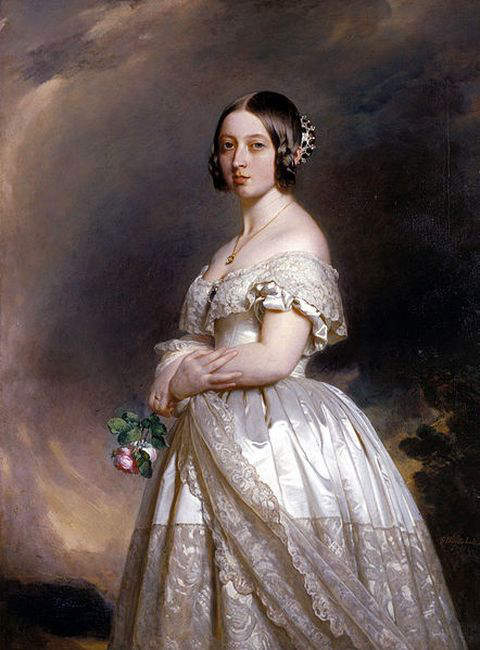
Queen Victoria in 1842 in her early twenties
Ornaments worn –
Gold chain with pendant.
Hair ornament
Brooch partially covered.
None of the ornaments above appear to incorporate any pearls.
Portrait by – Winterhalter, Franz Xavier
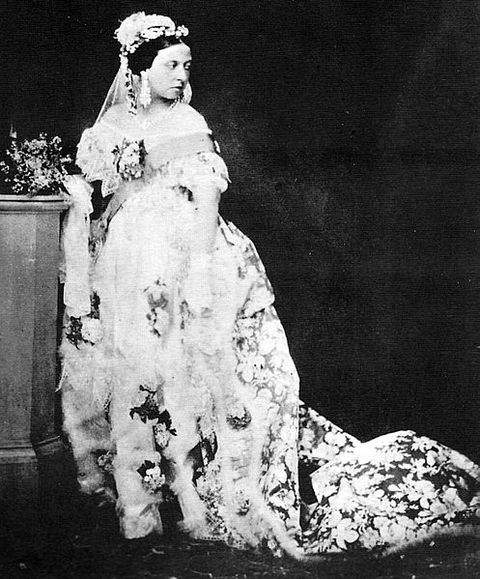
Queen Victoria photographed in her wedding gown around 1854
Ornaments worn –
Pendant earrings
Necklace
Hair ornament
Brooch or Stomacher
Bracelets
Photogrpher – Roger Fenton
The type of gemstones used in the above ornaments cannot be described with certainty, as unlike in color portraits black and white photographs do not have a color contrast that can bring out the actual properties of the gemstones. However, as in the previous portrait none of the ornaments above appear to incorporate any pearls.
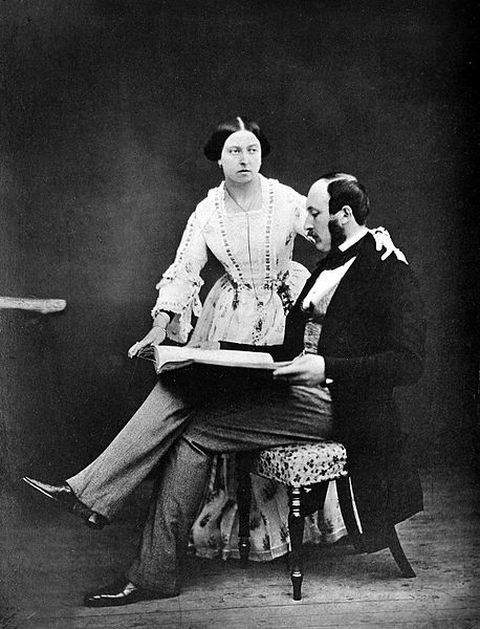
Photograph of Queen Victoria and Prince Albert taken in 1854 by Roger Fenton
Any ornaments worn by the Queen cannot be positively identified. But, certainly the Queen does not seem to be wearing any pearl ornaments.

1882-photograph of Queen Victoria at the age of 63 years
Ornaments worn –
Diamond necklace and pendant
Diamond pendant earrings
Diamond brooch
Diamond shoulder pin
A small crown probably studded with diamonds
As in the previous photographs and portraits, the Queen does not seem to be wearing any pearl ornaments.
Photograph by – Alexander Bassano
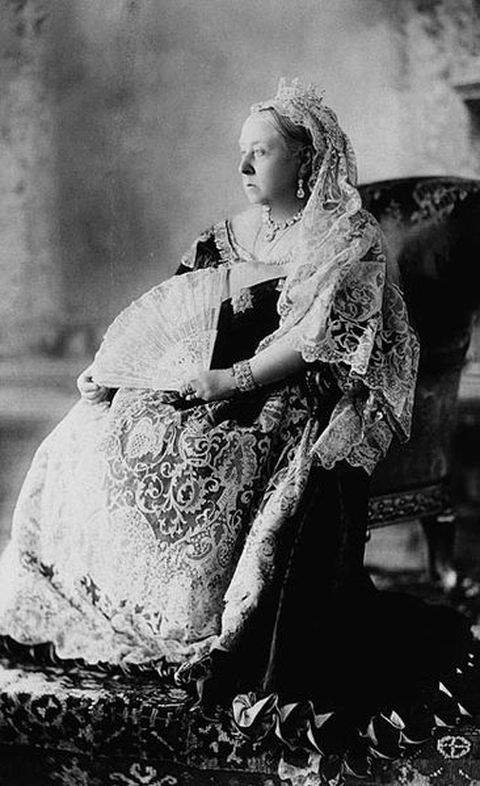
Queen Victoria’s diamond jubilee photograph taken in 1897
Ornaments worn –
Diamond necklace and pendant
Diamond pendant earrings
Diamond brooch
Diamond bracelet
A small crown probably set with diamonds
Even in this photograph the Queen does not seem to be wearing any pearl ornaments.
The above photographs seem to show that the Queen wore the minimum of jewelry for non-formal occasions. The jewelry she wore for formal occasions consisted mainly of diamond-set jewelry and not pearl jewelry as the spouses of the other British monarchs used to wear. Perhaps this was a deliberte attempt by the queen to popularize diamonds, that were being produced in large quantities in the recently opened diamond mines of South Africa. Perhaps it would have been a matter of her own personal preferences, or the Queen was just following the fashion trends of the period, instead of being a pace-setter herself. However, the fact that the queen was not wearing any pearl ornaments on any of these occasions, did not mean that pearls had gone out of fashion during this period. In fact it was during the mid-Victorian period from the 1840s to the 1860s that seed pearl jewelry reached the heigt of their popularity in Britain and later in other European countries and the United States. Seed pearl jewelry suites were the gift of choice given to young virgin girls, expecting to be given in marriage soon, and was a symbol of innocence and purity.
Appreciation of pearls by the Queen Consort of the only monarch of the House of Saxe-Coburg and Gotha, King Edward VII
Alexandra of Denmark – Queen Consort of Edward VII, King of the United Kingdom of Great Britain and Ireland, the British Dominions and Emperor of India from 1901 to 1910
Queen Victoria was succeeded by her eldest son, Prince Edward who held the title of Prince of Wales, and was heir apparent to the throne for longer than anyone else in history. He ascended the throne of the United Kingdom as King Edward VII, at the age of 60 years. His accession to the throne not only heralded the beginning of a new century, but also an era of fun and frivolity, after the long period of compulsory mourning by Queen Victoria during the latter part of her reign. Edward became one of the most popular kings of Great Britain and though his period of rule was short lasting between 1901 to 1910, it turned out to be a great success, with significant achievements both in the domestic and international fronts and helped to elevate the standing of the Brtish Royal family among its subjects, spread across the world. Edward, as the Prince of Wales undertook several international tours to north America, the Middle East and Asia, that gave him the opportunity to meet people of different cultural backgrounds and prepare him for his future role as king. During his tour of India in 1875, he complained to Queen Victoria about the treatment of native Indians by British offficials – “Because a man has a black face and a different religion from our own, there is no reason why he should be treated as a brute”
Prince Edward married Princess Alexandra of Denmark, the eldest daughter of Prince Christian of Denmark, on March 10, 1863. At the time of the marriage Edward was 21 and Alexandra 18. The marriage appeared to be a successful one producing six children within eight years, five of whom survived into adulthood. Their eldest son, Prince Albert Victor, the Duke of Clarence and Avondale, and second in line of succession to the British throne, who was engaged to Princess Mary of Teck, died of Pneumonia in 1892, at the age of 28 years devastating both the Prince and Princess of Wales. Their youngest son, John who was born in 1871, died just 24 hours after his birth.
Princess Alexandra, as the Princess of Wales from 1863 to 1901, won the hearts of the British people and became very popular. During the late-Victorian period she became a trend-setter in British society, and her mode and style of dressing was copied by fashion conscious women of Britain and Europe. High-necklines and choker-necklaces were some of the fashion trends introduced during her period, that lasted for several decades after her. When her husband, the Prince of Wales, Prince Edward ascended the throne in 1901 as King Edward VII, she became the Queen of the United Kingdom, the British Dominions and Empress of India. After her husband’s death in 1910, she became the dowager queen until her own death in 1925.
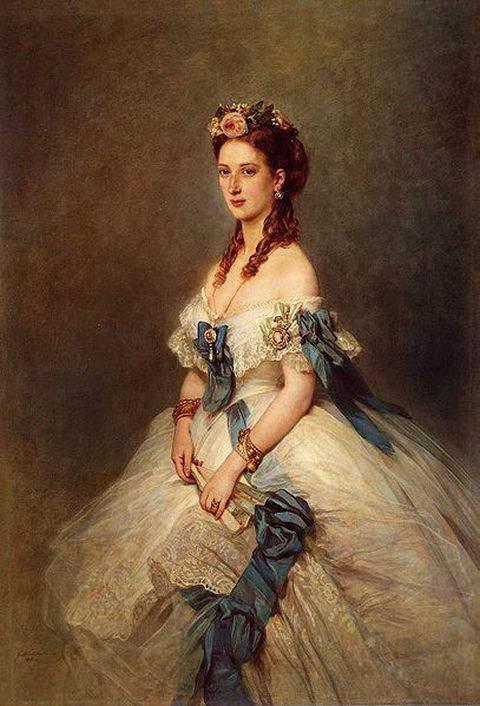
Princess Alexandra of Denmark, wife of Prince Albert Edward, and the Princess of Wales, at the age of 20 years
Ornaments worn –
Drop earrings incorporating spherical pearls.
Stomacher incorporating drop-shaped pearls.
Hair ornament incorporating pearls.
Bracelets incorporating pearls.
Portrait by – Winterhalter Franz Xaver in 1864
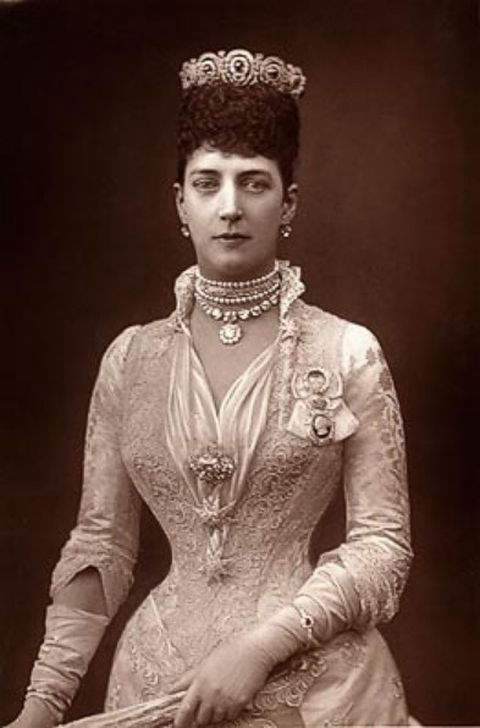
Photograph of the Princess of Wales, Princess Alexandra in her mid-forties by W & D Downey taken around 1889
Ornaments worn –
Two-strand pearl dog-collar necklace.
Diamond necklace and pendant.
Drop-earrings with spherical pearls.
Stomacher with pearls.
Tiara set with colored stones.
Bangle with a colored stone centerpiece.
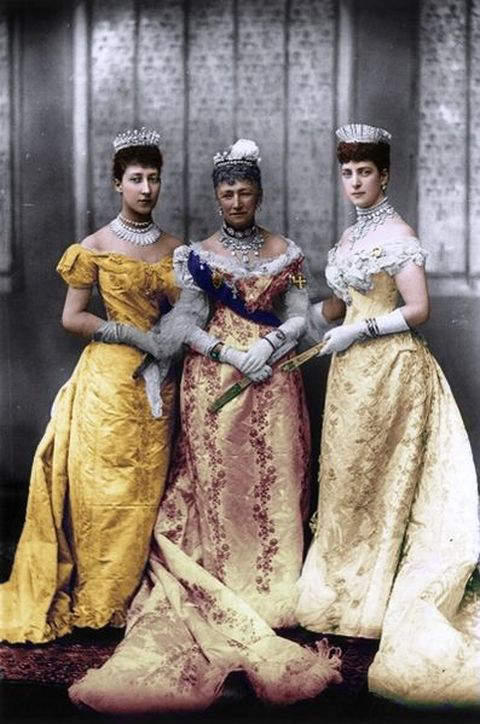
Princess Alexandra (right) with her mother Princess Louise of Hesse-Cassel (center) and her eldest daughter Princess Royal and Duchess of Fife, Louise (left).
Ornaments worn by Princess Alexandra –
Two-strand pearl dog-collar necklace
Diamond and pearl necklace with drop-shaped pearl fringes.
Tiara with vertical diamond spikes.
Drop-earrings with spherical pearls.
Bangle bracelets.
Ornaments worn by Princess Louise of Hesse-Cassel
Diamond and pearl necklace with drop-shaped pearl fringes.
Drop-earrings with pearls.
Tiara set with diamonds.
Bangle bracelets.
Ornaments worn by Princess Louise, Duchess of Fife
Tiara with drop-shaped pearl spikes.
Two-strand dog-collar pearl necklace.
Diamond fringe-necklace.
Bangle bracelets.
Colorized edited version of a black and white photograph created by W & D Downey in 1893
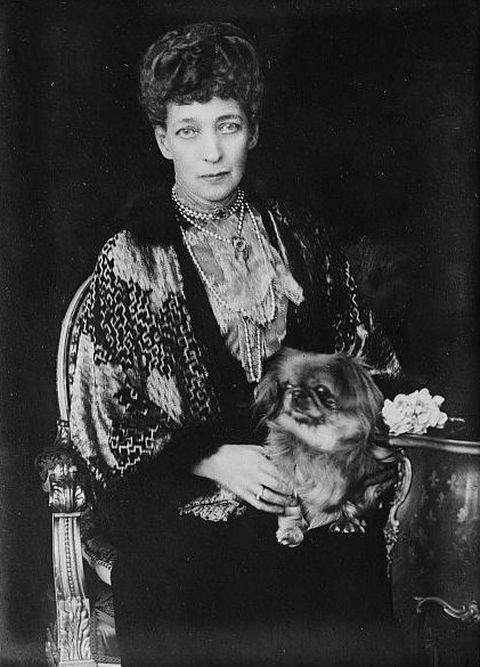
Queen Alexandra of Denmark in 1923 at the age of 79 years
Ornaments worn –
Double-strand pearl choker with a colored-stone centerpiece.
A single-strand pearl necklace with a colored-stone centerpiece.
Single-strand long pearl rope.
Press photograph from the Bain News Service
Appreciation of pearls by the monarchs and spouses of the House of Windsor
Mary of Teck – Queen Consort of George V, King of the United Kingdom and the British Dominions and the Emperor of India from 1910 to 1936
When Prince Edward ascended the throne in 1901 as King Edward VII, his second son, Prince George and his wife Princess Mary of Teck, the Duke and Duchess of York, became the Prince and Princess of Wales. On May 6, 1910, when King Edward VII died, Prince George ascended the throne as George V, King of the United Kingdom, the British Dominions and Emperor of India, and Princess Mary of Teck became his Queen consort. The coronation of King George V and Queen Mary was held on June 22, 1911, and in the same year the King and Queen traveled to India, where at a special durbar held in Delhi on December 12, 1911, they were proclaimed the Emperor and Empress of India.
In the aftermath of the first World War, most of the empires in Europe fell, while George V’s empire expanded to its greatest extent. In 1917, as a result of the anti-German public feeling preciptated by World War I, George V issued a royal proclamation that changed the name of the British Royal House from the German-sounding House of Saxe-Coburg and Gotha to the House of Windsor. Thus, King George V became the first monarch of the House of Windsor. He was widely admired by the people of Britain and the Empire. According to historian David Cannadine George V and Queen Mary were an inseparably devoted couple, who did much to uphold character and family values. Together they established a standard of conduct for British royalt that reflected the values and virtues of the upper middle-class rather than upper-class lifestyles and vices.
Queen Mary has gone down in history as the queen who did more to project the image of the queen as a stately, heavily bejeweled and dignified figure than any other English queen had done in the history of the British monarchy. She is also credited with setting the tone of the British Royal Family, as a model of regal formality and propriety, especially during state occasions. She became famous for superbly bejeweling herself for formal events, and her crowning moment of glory came in 1913, when she was hailed as the most spectacular royal guest at the wedding of Kaiser Wilhelm’s daughter, which she attended heavily bedecked with jewelry. She also developed a great passion for collecting objects of art, jewels and jewelry, and other objects with a royal provenance, such as porcelain, cameos, royal seals, Faberge animals and eggs, jeweled fans, gold boxes encrusted with jewels etc. She is credited with transforming the British Royal Family’s jewel collection, both the crown jewels and the personal jewelry collection, into one of the greatest jewelry collections in the world. Among the notable jewelry collections she acquired were the Romanov jewels, that once belonged to Russia’s Dowager Empress Marie Feodrovna, mother of Czar Nicholas II, the last Czar of Russia, and sister of England’s Queen Alexandra, and jewels belonging to Grand Duchess Maria Vladimir Alexandrovich, the aunt of Czar Nicholas II.
After the death of her husband, George V, in January 1936, her eldest son Edward ascended the throne as Edward VIII, but to her dismay he abdicated the same year in December in order to marry the twice-divorced American socialite Mrs. Wallis Simpson. She then gave all the support and encouragement to her second son, Albert, who succeeded to the throne as King George VI, and survived through his entire period of rule until 1952, and died the following year at the beginning of the reign of her granddaughter Queen Elizabeth II.
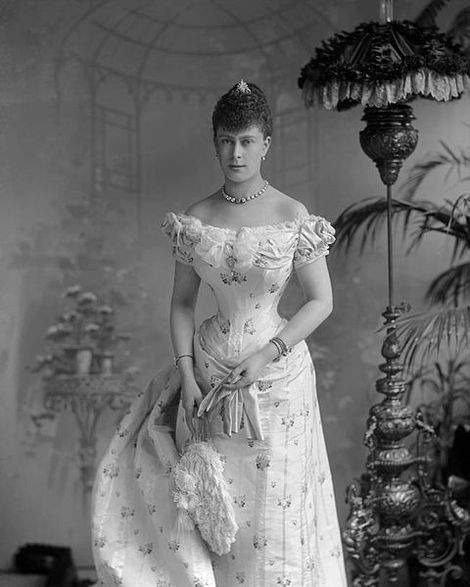
Princess Mary of Teck in 1893, shortly before her marriage to Prince George, the Duke of York
Ornaments worn –
Single-strand pearl necklace.
Pearl drop-earrings.
Hair ornament.
Bangle bracelets.
Photograph by – James Stack Lauder
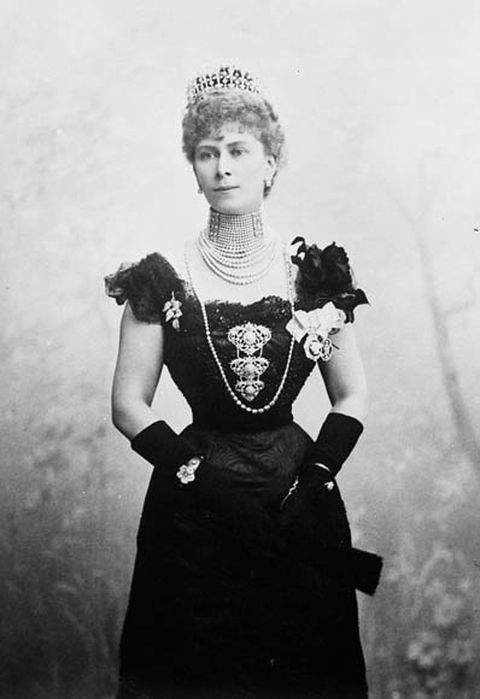
Princess Victoria Mary, the Duchess of Cornwall and York in 1901 at Ottawa, in Canada
Ornamens worn –
Multistrand dog-collar pearl necklace.
Seven-strand pearl necklace which may perhaps be part of the dog-collar necklace or separate from it.
Single-strand long pearl rope necklace.
Stomacher with centerpiece set with large spherical pearls.
Brooch set with pearls.
Pearl drop-earrings.
A tiara.
Photograph by – Topley Studio of Ottawa, Canada.
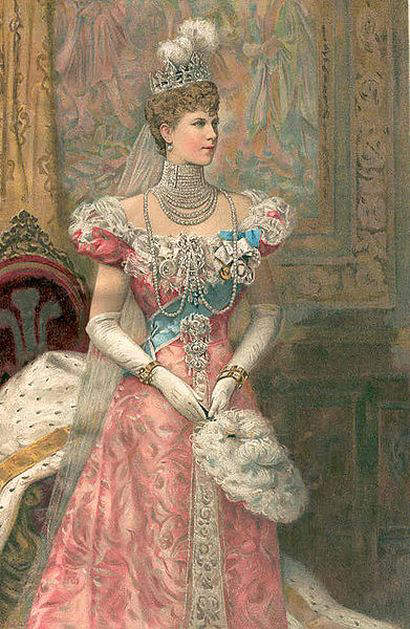
Princess of Wales, Victoria Mary at court in 1902
Ornaments worn –
Mulistrand dog-collar pearl necklace, with five loose strands in front which is part of the same necklace.
Long pearl rope with its bottom raised up to form a double loop.
Stomacher set with pearls.
Second stomacher below the first, also set with pearls, along the midline of the dress.
Pearl drop-earrings.
Tiara set with pearls.
Bracelets.
The above is a chromolithograph of Queen Mary published in “The Illustrated London News” of June 26, 1902.
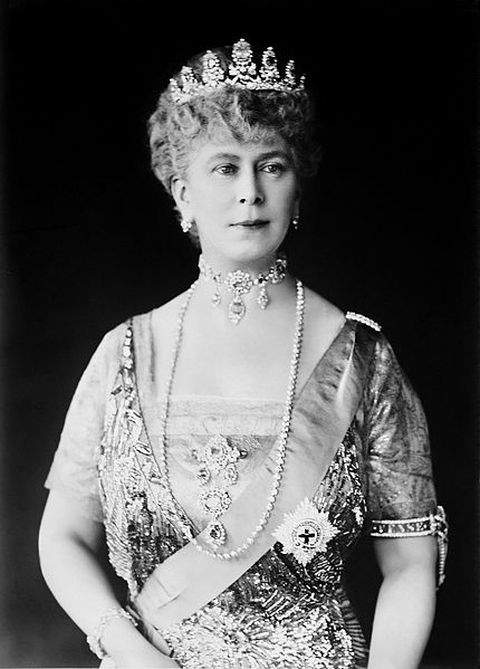
Formal portrait of Queen Mary, Queen Consort of King George V, King of the United Kingdom, the British Dominions and Emperor of India
Ornaments worn –
Diamond and colored stone fringe necklace.
Diamond-set earrings.
Colored stone and diamond-set tiara.
Colored stone and diamond-set stomacher
Single-strand pearl rope necklace
Press photograph by Bain News Service.

King George V and Queen Mary during a formal occasion
The above is a photograph of King George V and Queen Mary dressed in formal royal robes and crown for a state occasion, perhaps for a State Opening of Parliament, and standing in front of the royal coat-of-arms. The image is from the Library and Archives of Canada. The date of the photograph is however not known, but appears to be during the latter part of his reign that extended from 1910 to 1936. In keeping with her well-known practice of superbly bejeweling herself for formal events, on this occasion too the Queen has used a complete set of ornaments, such as multistrand necklaces, drop-earrings, brooches, stomacher, and bracelets apart from the formal crown signifying her royal status.
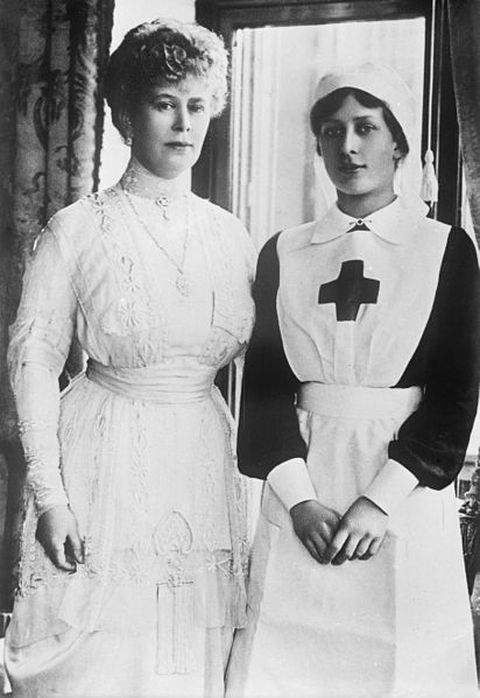
Queen Mary with her daughter Princess Mary during World War I
During World War I, Queen Mary visited regularly the wounded and dying serviceman in hospital, and encouraged her daughter Mary, the Princess Royal and Countess of Harewood, to join as a volunteer nurse to take care of the sick and wounded. The above is a photograph of the Queen taken with her daughter, the Princess Royal at the time of her visit to the hospital. Dressed appropriately for the occasion, the Queen seem to be wearing some simple jewelry, such as a chain and pendant, a brooch and earrings.

Queen Mary wearing the Cambridge and Delhi Dunbar Parure
The above is a photograph of Queen Mary wearing the famous Cambridge and Delhi Dunbar Parure, a complete suite of emerald jewelry, that was designed by the Crown Jewelers, in anticipation of the coronation of King George V and Queen Mary on June 22, 1911, and their subsequent proclamation as the Emperor and Empress of India, at a special durbar that was to be held in Delhi, on December 12, 1911. The parure consisted of the following six components, all of which can be seen adorning the person of Her Majesty:-
The Delhi Dunbar tiara
The Cambridge emerald choker
The Cambridge emerald earrings
The Delhi Dunbar Necklace
The Delhi Dunbar brooch
The Cambridge emerald stomacher
Apart from the above components, the Queen can also be seen wearing three diamond collet necklaces, between the Cambridge emerald choker and the Delhi Dunbar necklace with the negligee pendants.
Another striking feature of the Queen’s attire is the large number of seed pearls emboidered on it, especially on the right half of her dress and the sleeves.
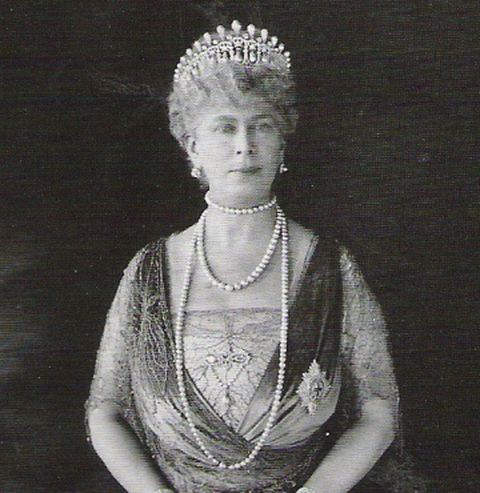
Queen Mary wearing the Cambridge Lover’s Knot tiara with the pearl spikes intact
The above is another photograph of Queen Mary dressed up for a formal occasion.
Ornaments worn –
The Cambridge Lover’s Knot tiara made of 38 drop-shaped pearls, 19 hanging as pendants and 19 rising-up as spikes.
Pearl choker necklace.
Single-strand long pearl rope twisted around the neck as a double-strand necklace of different lengths.
Stomacher incorporating pearls.
Brooch
Earrings set with pearls.
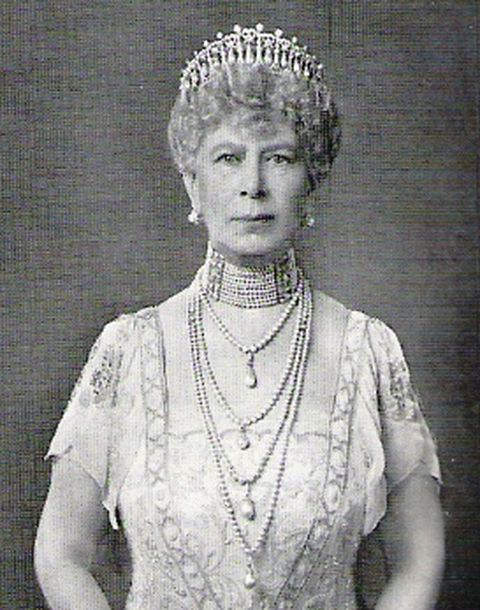
Queen Mary wearing the modified version of the Lover’s Knot tiara
Another photograph of Queen Mary dressed up for a formal occasion.
Ornaments worn –
Modified version of the Lover’s Knot tiara with the pearl spikes removed.
Multi-strand pearl dog-collar necklace.
Four strand pearl necklace, using four drop-shaped pearls removed from the spikes as pendants.
Elizabeth Bowes-Lyon – Queen Consort of George VI, King of the United Kingdom and the British Dominions and the Emperor of India (until 1948) from 1936 to 1952
George VI, whose full name was Albert Frederick Arthur George, was born in 1895 and was the second son of King George V and Queen Mary. At the time of his birth he was 4th in the line of succession to the throne, after his grandfather (Prince Albert Edward), his father (Prince George Frederick), and elder brother (Prince Edward). In 1901, when his grandfather ascended the thone as King Edward VII, he became the 3rd in the line of succession; and in 1910, when his father ascended the throne as King George V, his elder brother Prince Edward became the Prince of Wales and Albert became the second in line of succession to the throne. In 1920, Prince Albert was created the Duke of York, the same year he met Lady Elizabeth Bowes-Lyon, the youngest daughter of the Earl and Countess of Strathmore and Kinghorne, but under British law still considered a commoner. Elizabeth rejected Prince Albert’s proposal on two occasions due to her reluctance to make sacrifices that would necessarily entail, if she became a member of the royal family. However, eventually she agreed and Albert and Elizabeth were married on April 26, 1923. The marriage of the Duke of York to a commoner was hailed by many as a progressive step, and Elizabeth was referred to as Her Royal Highness, the Duchess of York, after the marriage. The marriage proved to be a very successful one, and the Duke and the Duchess had two children, Elizabeth and Margaret. The Duchess also proved to be a source of inspiration and encouragement to her stammering husband, who after undergoing speech therapy and rehearsing patiently with the Duchess, successfully delivered the opening address at Australia’s Federal Parliament at Canberra in 1927. After further training the Duke was subsequently able to speak with only a slight hesitation. As the Duchess of York, Elizabeth undertook several public engagements, and became very popular among the public, earning the name, the “smiling duchess.”
In January 1936, when King George V died, he was succeeded by his eldest son, the Prince of Wales, Prince Edward, who ascended the throne as King Edward VIII. As Edward was not married and not yet had any legitimate children, his brother Prince Albert became the heir presumptive, until his brother was able to marry and have children. However, less than an year later on December 11, 1936, King Edward VIII abdicated the throne, to enable him marry his mistress, the twice divorced American socialite, Wallis Simpson. This sudden and unexpected development opened the way for Edward’s immediate younger brother, Prince Albert, who was the heir presumptive, to ascend the throne, which he did reluctantly on December 11, 1936, taking the name, King George VI, and the Duchess of York, Elizabeth Bowes-Lyon became his Queen Consort. They were crowned as the King and Queen of the United Kingdom, and the British Dominions, and the Emperor and Empress of India, on May 12, 1937.
As Queen consort, Elizabeth accompanied her husband on State visits to France in 1938 and to Canada and the United States in 1939, to bolster relations with these countries, with the aim of forming a united front in the face of Nazi aggression. During the war her indomitable spirit became a source of inspiration and moral support to the British people, and her popularity as well as that of the British monarchy soared, when she and the king publicly refused to leave London or send the children to a safer location, even during the Blitz, as advised by the Cabinet. After the war the Kings health began to deteriorate, and Elizabeth devoted most of her time to look after her ailing husband. On February 6, 1952, King George VI died peacefully in his sleep, and his eldest daughter, Princess Elizabeth Alexandra Mary, ascended the throne as Queen Elizabeth II. After the death of her husband Queen Elizabeth was referred to as Her Majesty Queen Elizabeth, the Queen Mother or popularly as just the Queen Mother, to avoid confusion with the reigning monarch, Queen Elizabeth II.
After a short period of mourning the Queen Mother resumed her public duties, as well as undertaking overseas tours, such as her tour to Zimbabwe in 1953 and 1957, Australia, New Zealand and Fiji in 1966 and later to Iran in 1975. She was a connoisseur and collector of art works, such as paintings, Faberge eggs as well as jewelry. Her interest in horse racing, particularly steeple chase, led to her becoming a horse owner, and her horses emerged as cup winners in many racing events. Before the marriage of Lady Diana Spencer to the Prince of Wales, Prince Charles, the Queen Mother, known for her personal and public charm, was the most popular member of the royal family. Her signature dress of large upturned hat with netting, and dresses with draped panels of fabric, and multi-strand pearl necklace, became a distinctive personal style, with which she was always associated. The Queen Mother in her later life also became an international symbol of longevity. However, in her sixties she had undergone an appendectomy and a surgical operation for colon cancer and later in her eighties another operation for the removal of a cancerous lump from one of her breasts. The Queen Mother had a remarkable ability to withstand the rigours of surgical procedures at an advanced age, and at the age of 95, she underwent two operations for the removal of a cataract in her left eye and to replace her right hip, and another operation at the age of 98 to replace her left hip after it was fractured as a result of a fall. She celebrated her 100th-birthday on August 4, 2000. She had two more accidents, one in November 2000 when she broke her collar bone, and the other in December 2001 when she fractured her pelvis after a fall. Her daughter Princess Margaret died on February 9, 2002, and the Queen Mother attended her funeral on a wheelchair on February 15, 2002, despite a fall she had two days earlier in which she cut her arm. Seven weeks after her daughter’s death, the Queen Mother died in her sleep on March 30, 2002, at the Royal Lodge, Windsor Great Park, with her surviving daughter, Queen Elizabeth II, at her bedside. At the time of her death she was 101 years and 7 months old, the longest-lived member of the royal family in British history.
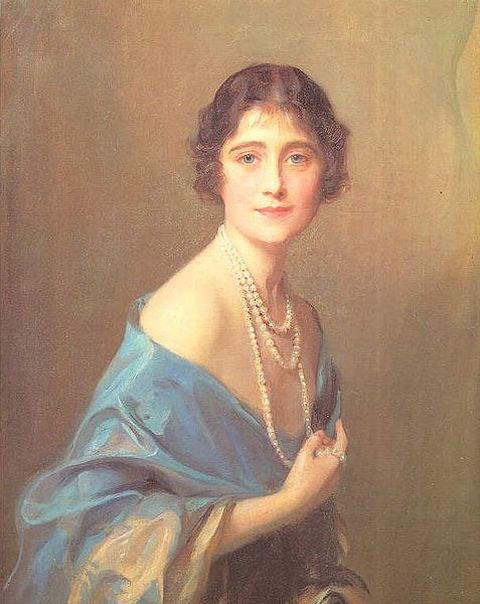
Portrait of Elizabeth Bowes-Lyon, the Duchess of York, executed by Philip Alexius de Laszio in 1925
Ornaments worn –
A three-strand pearl necklace
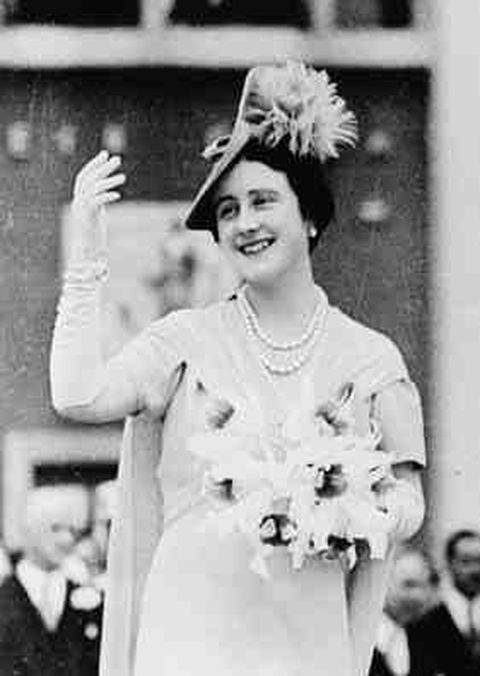
Queen Elizabeth Bowes-Lyon, Queen Consort of King George VI, at the 1939 New York World Fair
Ornaments worn –
Double-strand pearl necklace
Pearl drop-earrings.

King George VI and Queen Elizabeth at the Canadian Pavilion of the New York World Fair in 1939
Ornaments worn by the Queen –
Double-strand pearl necklace
Pearl drop-earrings

Portrait of Queen Elizabeth by Sir Gerald Kelly executed between 1938 and 1945
Ornaments worn –
Two-strand necklace
Drop-earrings
Bracelets
No pearls seem to be associated with any of these ornaments.
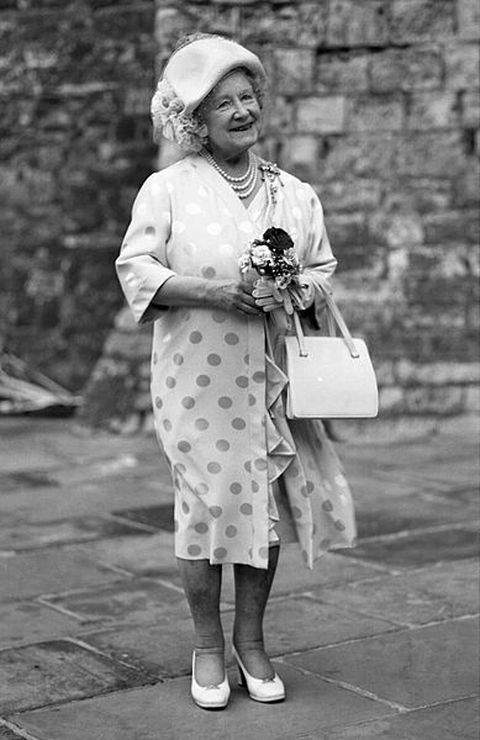
Queen Mother at Dover Castle, Kent – Photograph by Allan Warren
Ornaments worn –
Three-strand pearl necklace
Brooch
Queen Elizabeth II – Constitutional monarch of the Commonwealth Realms including the United Kingdom and Head of the Commonwealth of Nations from 1952 to date

Coronation portrait of Queen Elizabeth II and Prince Philip, Duke of Edinburgh taken by unknown Canadian photographer of the National Film Board of Canada in June 1953
Ornaments worn –
Ornaments worn by the Queen apart from the coronation crown, include a necklace, drop-earrings, brooches and bracelets, whose details are not clearly visible at the distance the photograph had been taken.
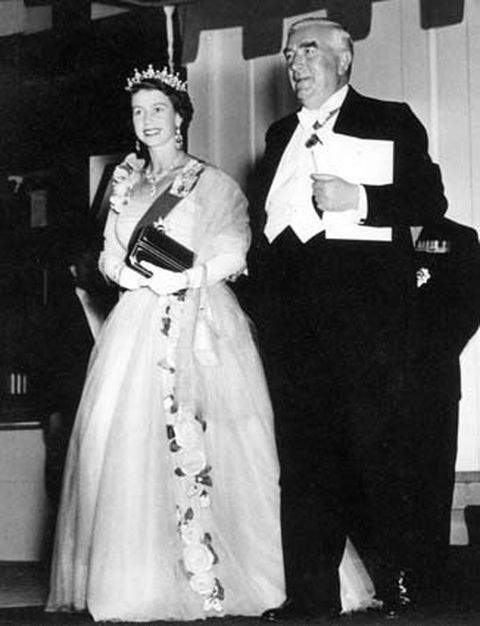
Queen Elizabeth with Sir Robert Menzies, the Prime Minister of Australia in 1954
Ornaments worn –
The Queen can be seen wearing a tiara, necklace with pendant, drop-earrings, brooches and bracelets, whose details cannot be provided at the distance the photograph has been taken.

Queen Elizabeth II at NASA’s Goddard Space Flight Center in 2007
Ornaments worn –
Earrings with large white spherical pearl.
Multistrand pearl necklace partly visible above the neckline of her dress.
Brooch depicting a rose and surrounded by row of pearls.
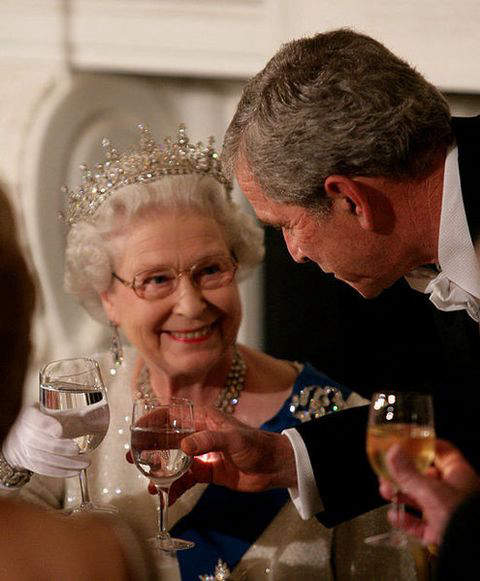
President George W. Bush toasts Her Majesty Queen Elizabeth II, during a State Dinner in her honor at the White House
Ornaments worn –
Tiara with spikes set with diamonds.
Three-strand diamond necklace.
Diamond brooch.
Drop-earrings set with diamonds.
More photographs of Her Majesty Queen Elizabeth II wearing different types of pearl jewelry on different occasions, either inherited by her or belonging to the crown jewels of Britain, are available but cannot be reproduced here due to respect for copyrights, a policy stringently followed by our website. The use and appreciation of pearls reached a climax in the British monarchy only between 1910 and 1936, during the rule of King George V of the House of Windsor, whose Queen Consort, Queen Mary, as pointed out earlier was well known for superbly bejeweling herself for formal events, and has gone down in history for projecting the image of the queen as a stately, heavily bejeweled and dignified figure, and the royal family as a model of regal formality and propriety during state occasions.
The Use and Appreciation of Pearls by the monarchies of Spain and Portugal in the Middle Ages and until modern times
The use and appreciation of pearls by the monarchies of Spain and Portugal in the middle ages and thereafter will be considered in detail in the next webpage, “History ofthe Discovery and Appreciation of Pearls – Page 8.”
You are welcome to discuss this post/related topics with Dr Shihaan and other experts from around the world in our FORUMS (forums.internetstones.com)
Related :-
1) History of the discovery & appreciation of Pearls- Part 1
2) History of the discovery & appreciation of Pearls- Part 2
3) History of the discovery & appreciation of Pearls- Part 6
4) Cambridge and Delhi Dunbar Parure
5) Diana Princess of Wales Swan Lake Suite
6) Queen Mary Conch Pearl Brooch
References :-
1) Alexandra of Denmark – From Wikipedia, the free encyclopedia
2) Mary of Teck – From Wikipedia, the free encyclopedia
3) Elizabeth Bowes-Lyon – From Wikipedia, the free encyclopedia
4) Elizabeth II – From Wikipedia, the free encyclopedia
5) Queen Victoria – From Wikipedia, the free encyclopedia
6) Adelaide of Saxe-Meiningen – From Wikipedia, the free encyclopedia
7) Caroline of Brunswick- From Wikipedia, the free encyclopedia
8) Charlotte of Mecklenberg-Strelitz – From Wikipedia, the free encyclopedia
9) Caroline of Ansbach – From Wikipedia, the free encyclopedia
10) Sophia Dorothea of Celle – From Wikipedia, the free encyclopedia
11) Eugenie de Montijo – From Wikipedia, the free encyclopedia
12) Maria Amalia of Naples and Sicily – From Wikipedia, the free encyclopedia
13) Marie Louis, Duchess of Parma – From Wikipedia, the free encyclopedia
14) Josephine de Beauharnais – From Wikipedia, the free encyclopedia
15) Marie Antoinette – From Wikipedia, the free encyclopedia
16) Marie Leszczynska – From Wikipedia, the free encyclopedia
17) Francoise d’Aubigne, marquise de Maintenon – From Wikipedia, the free encyclopedia
18) Maria Theresa of Spain – From Wikipedia, the free encyclopedia
19) Anne of Austria – From Wikipedia, the free encyclopedia
20) Marie de Medici – From Wikipedia, the free encyclopedia
21) Margaret of Valois – From Wikipedia, the free encyclopedia
22) Henry IV of France – From Wikipedia, the free encyclopedia

